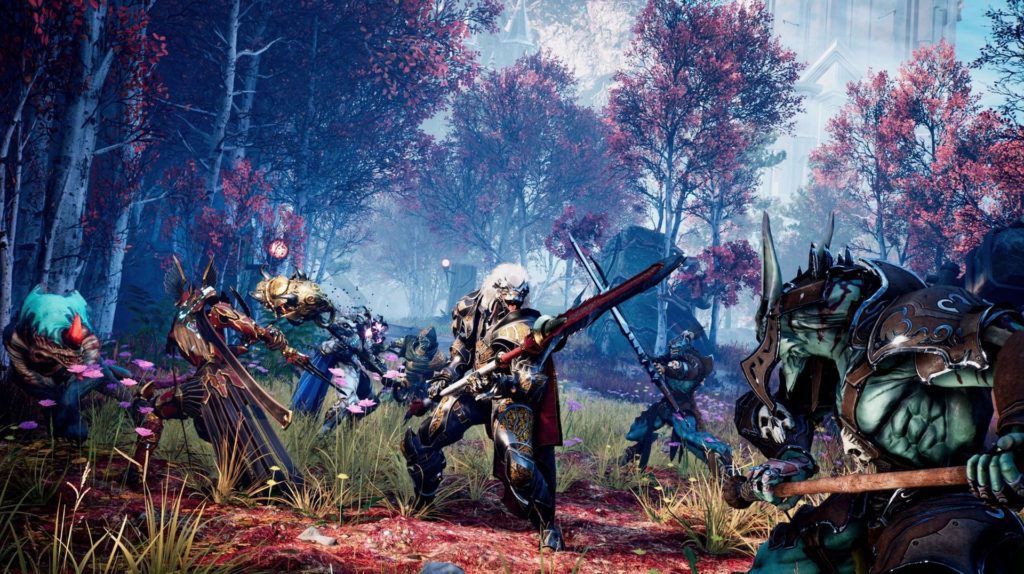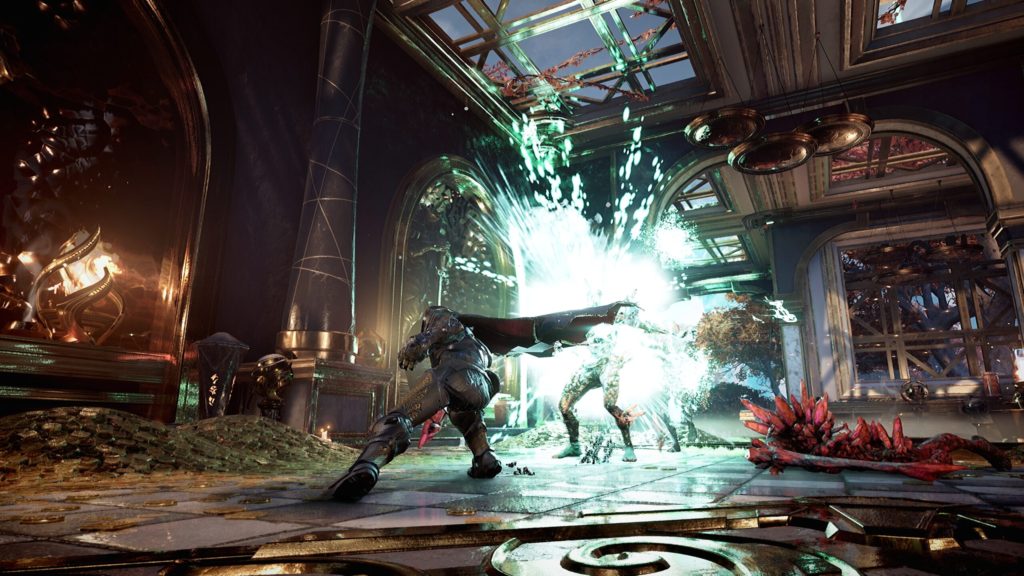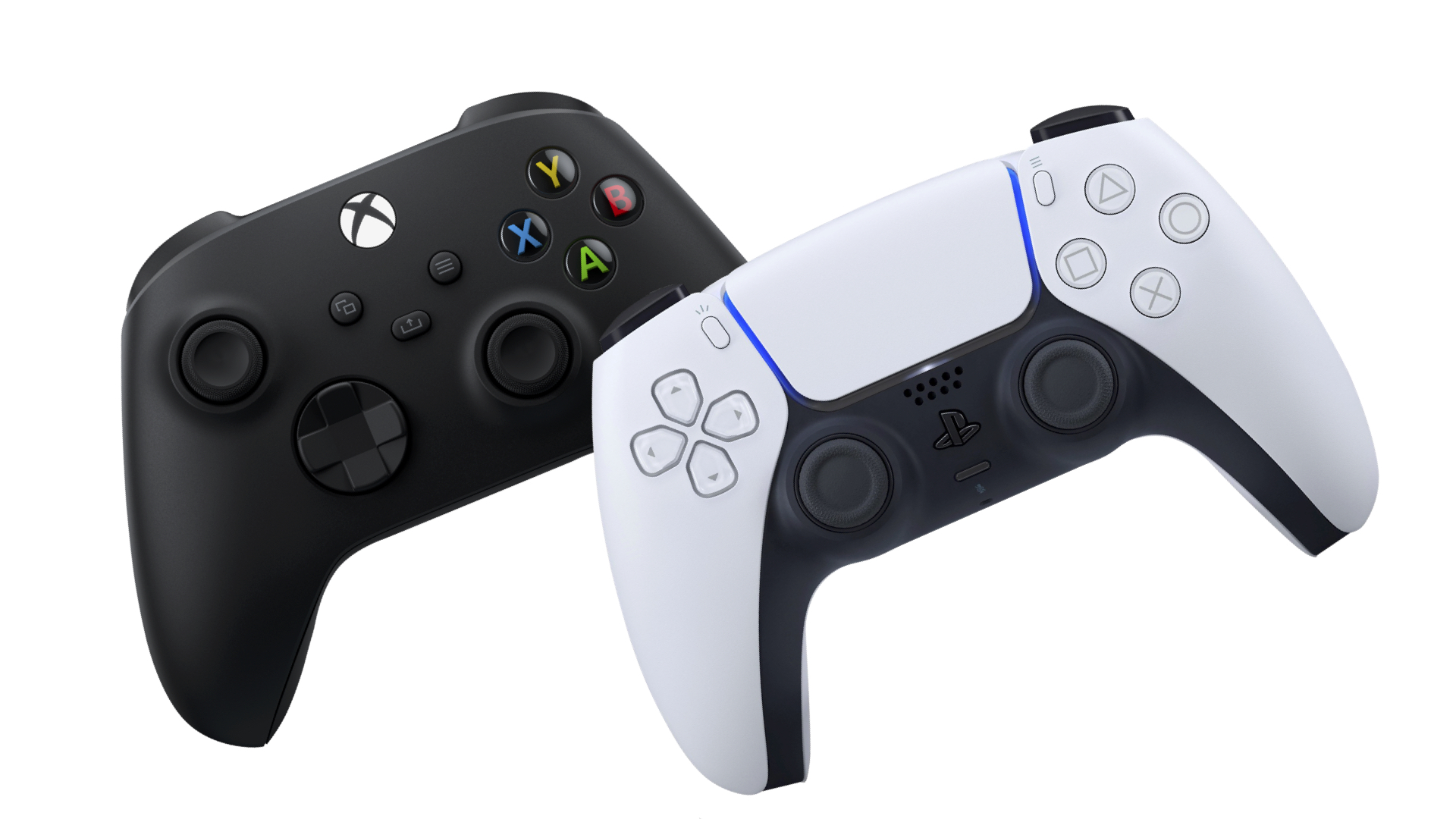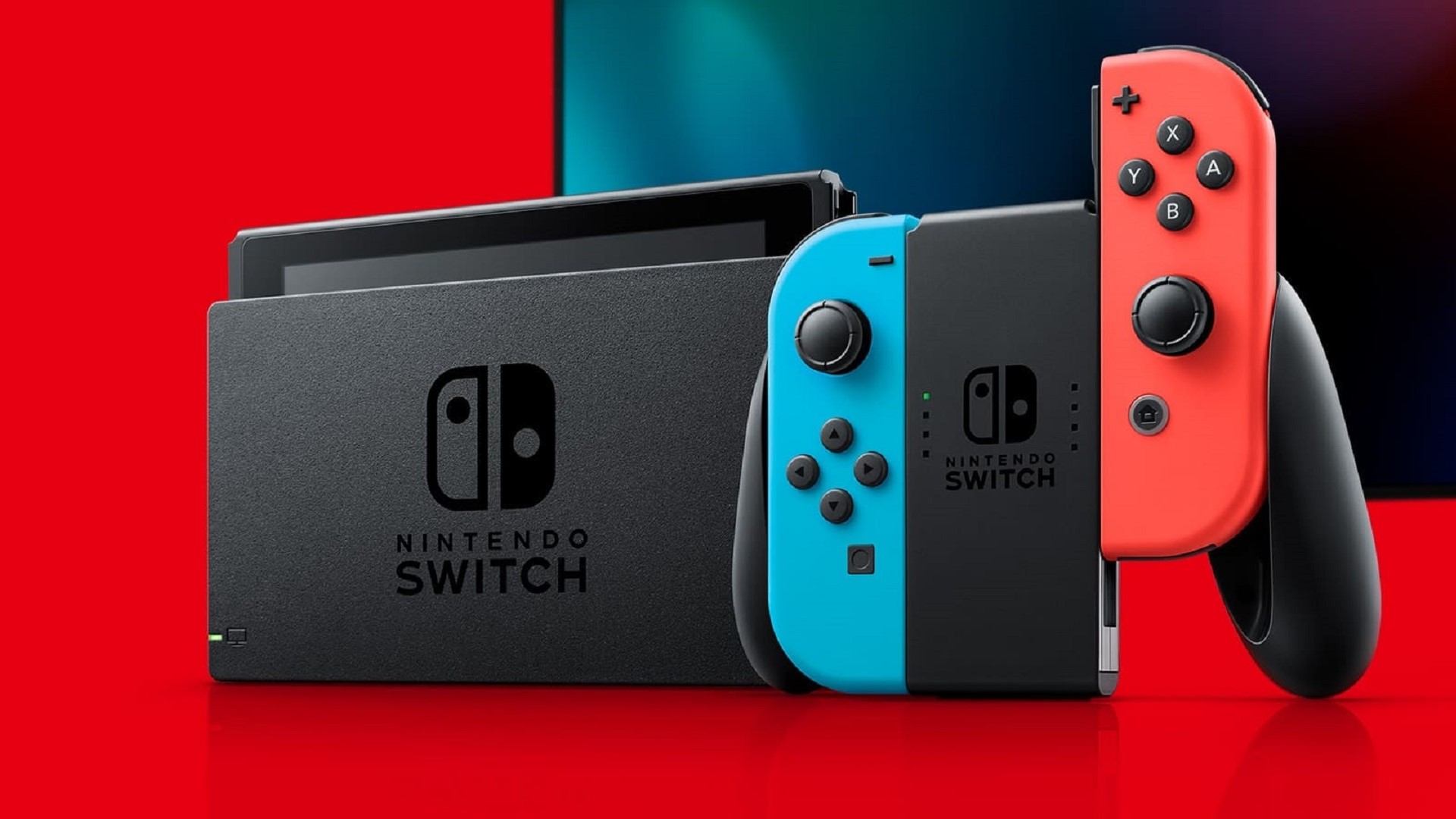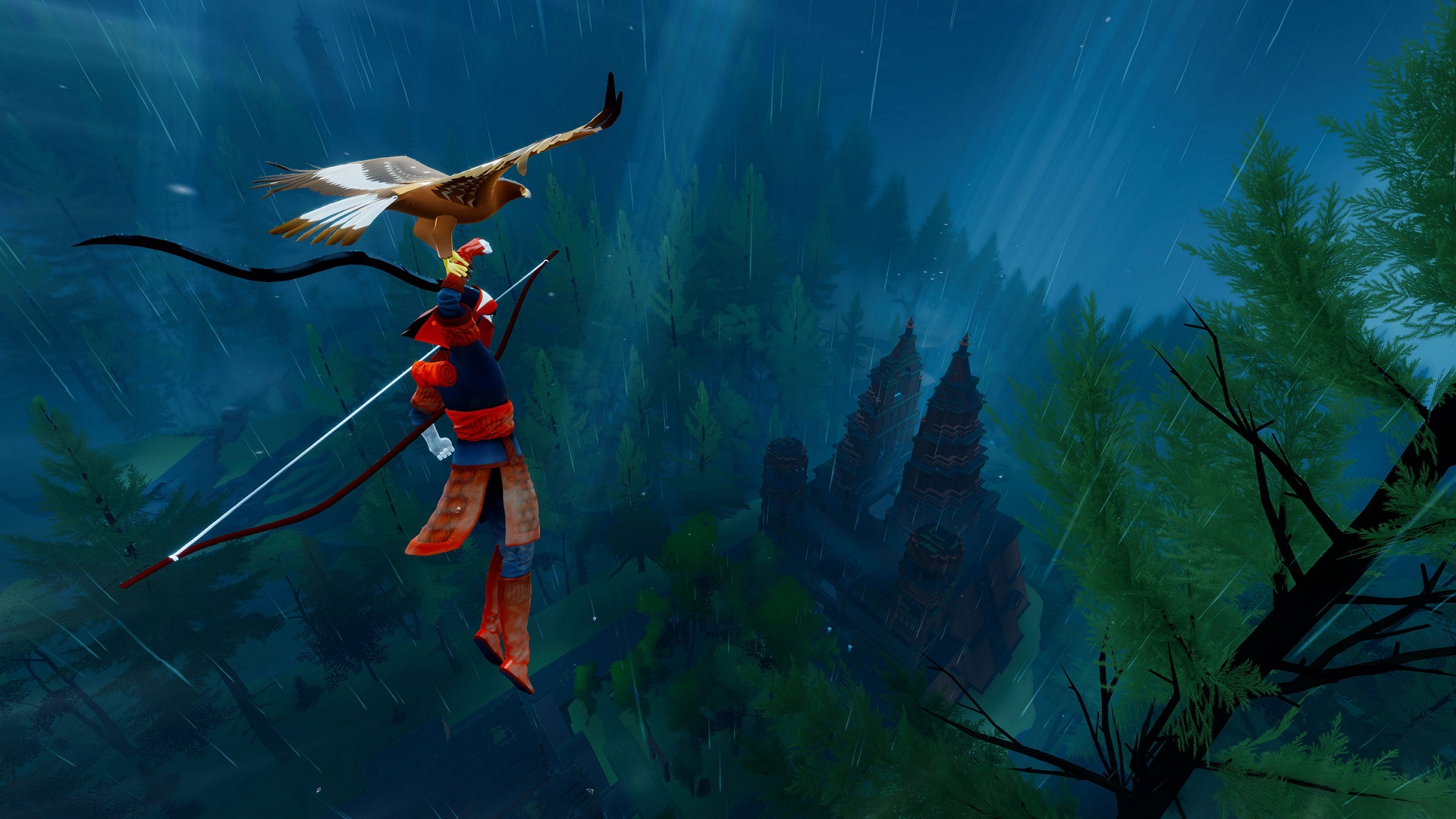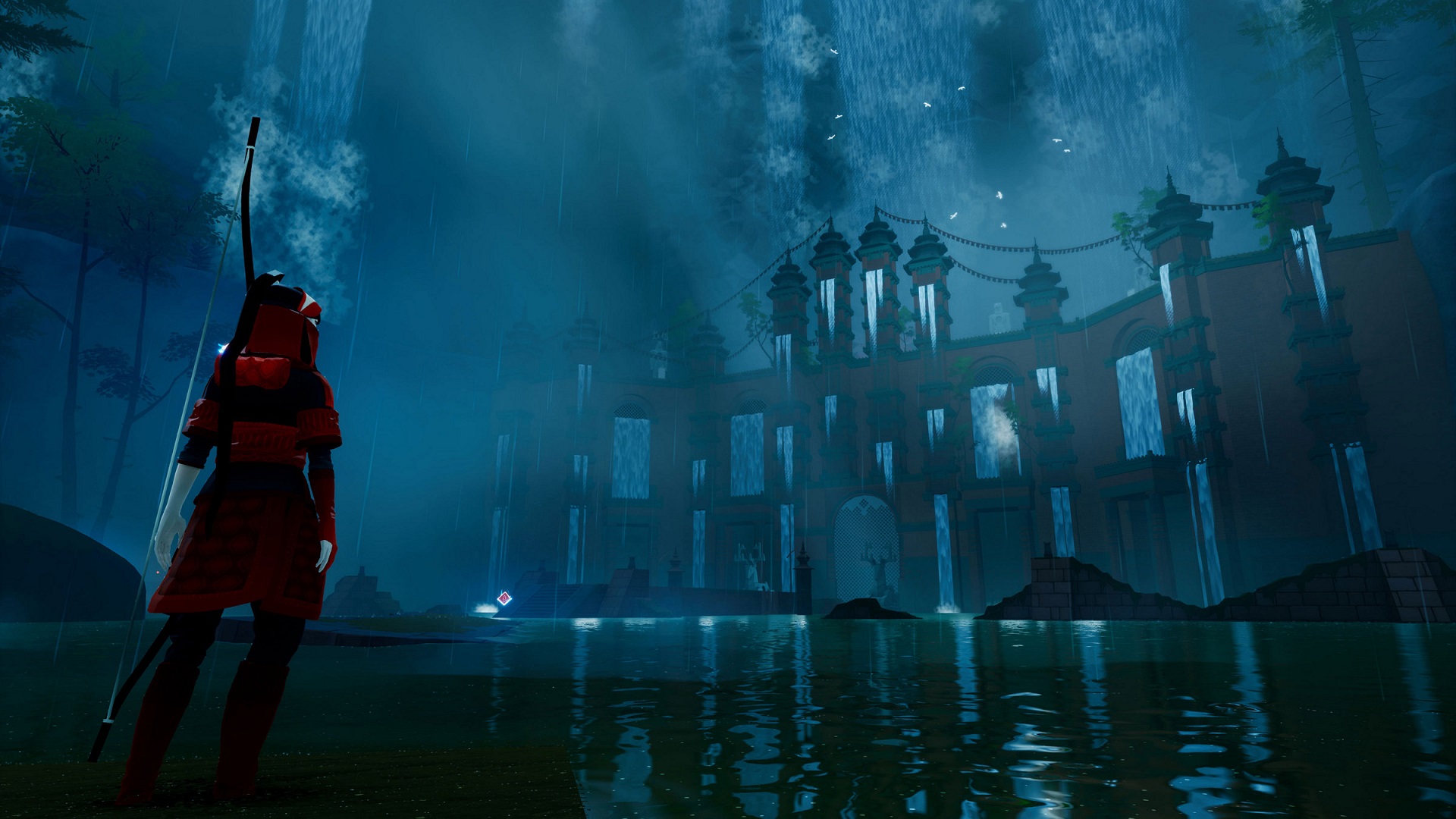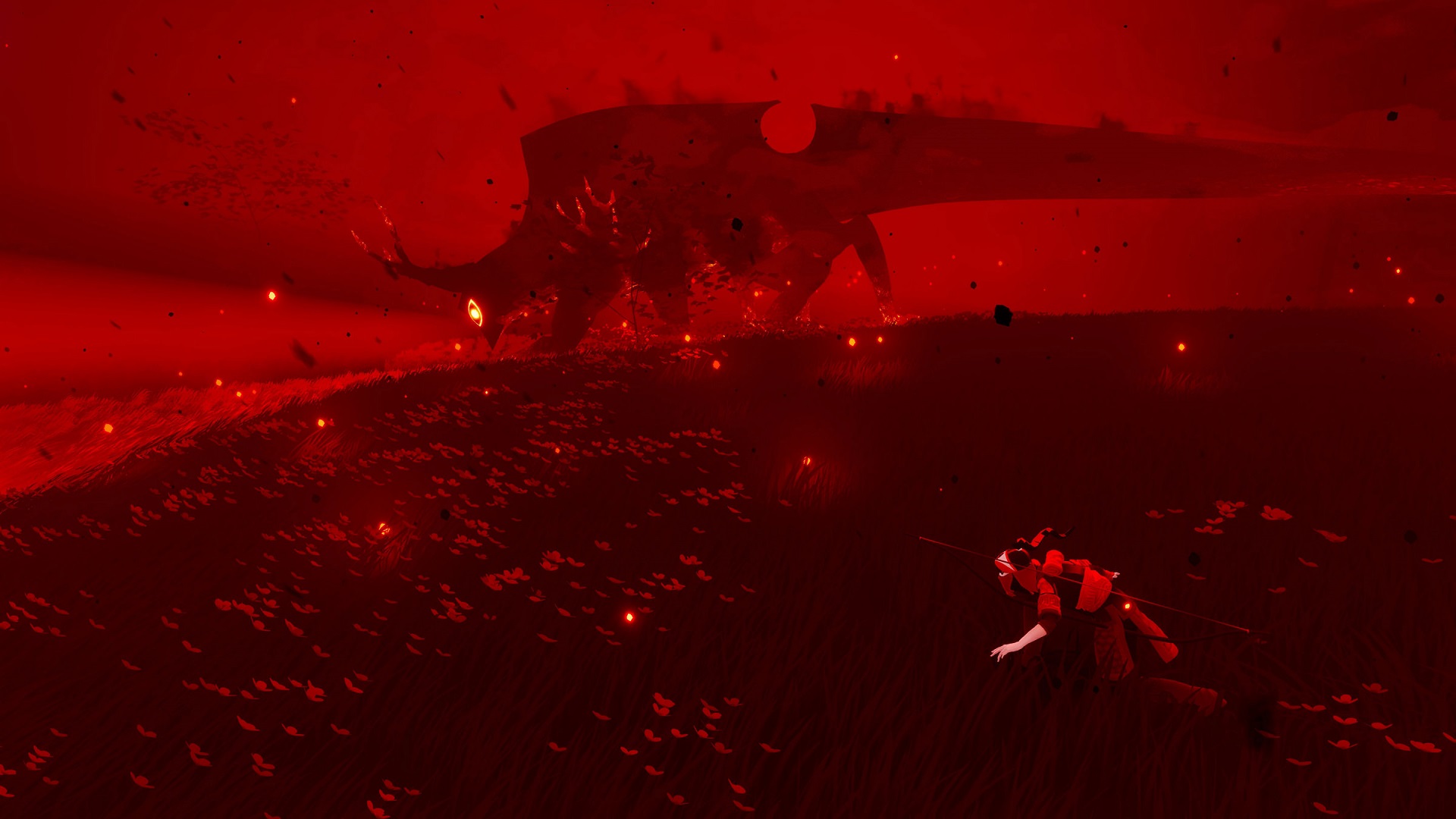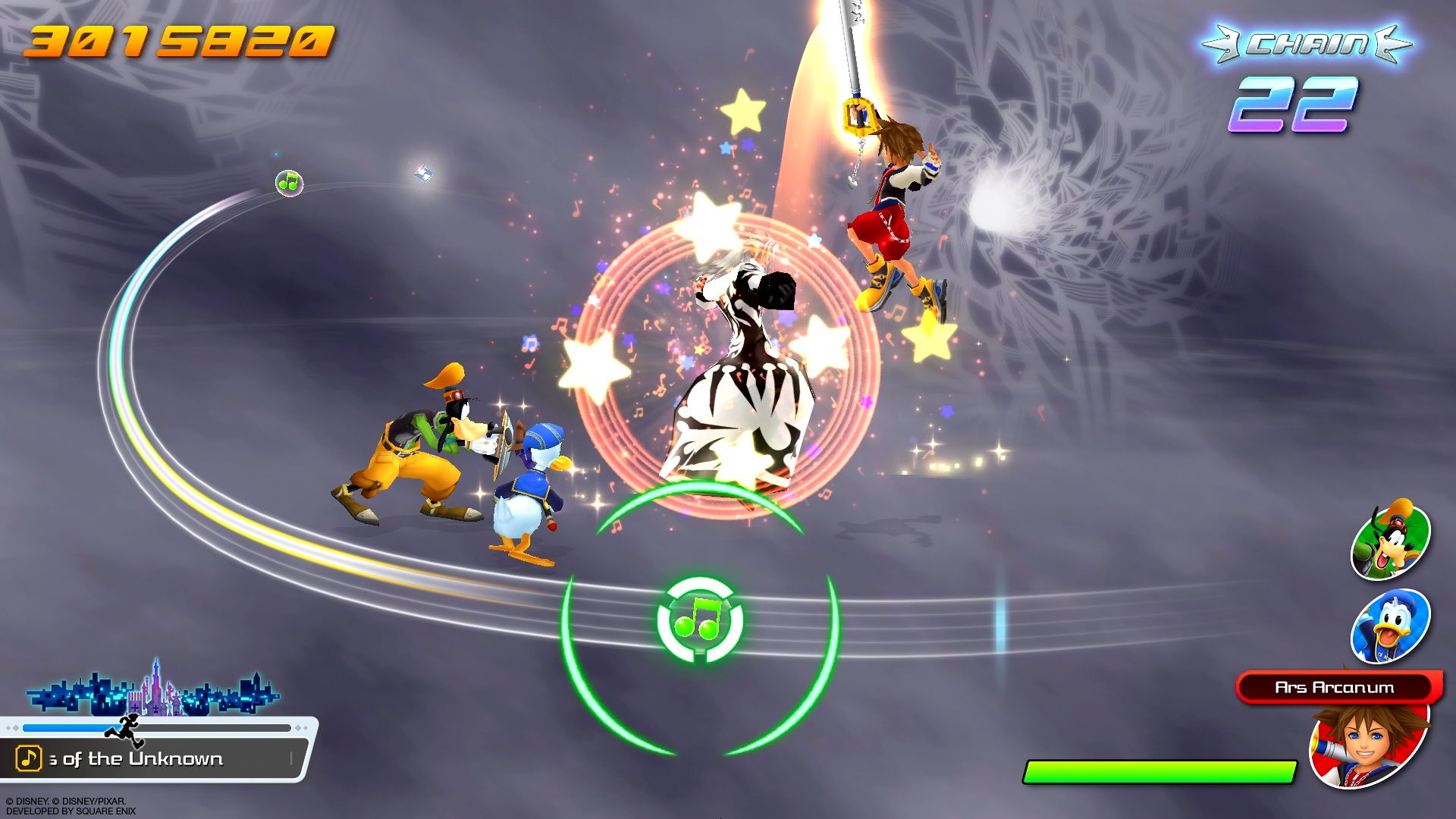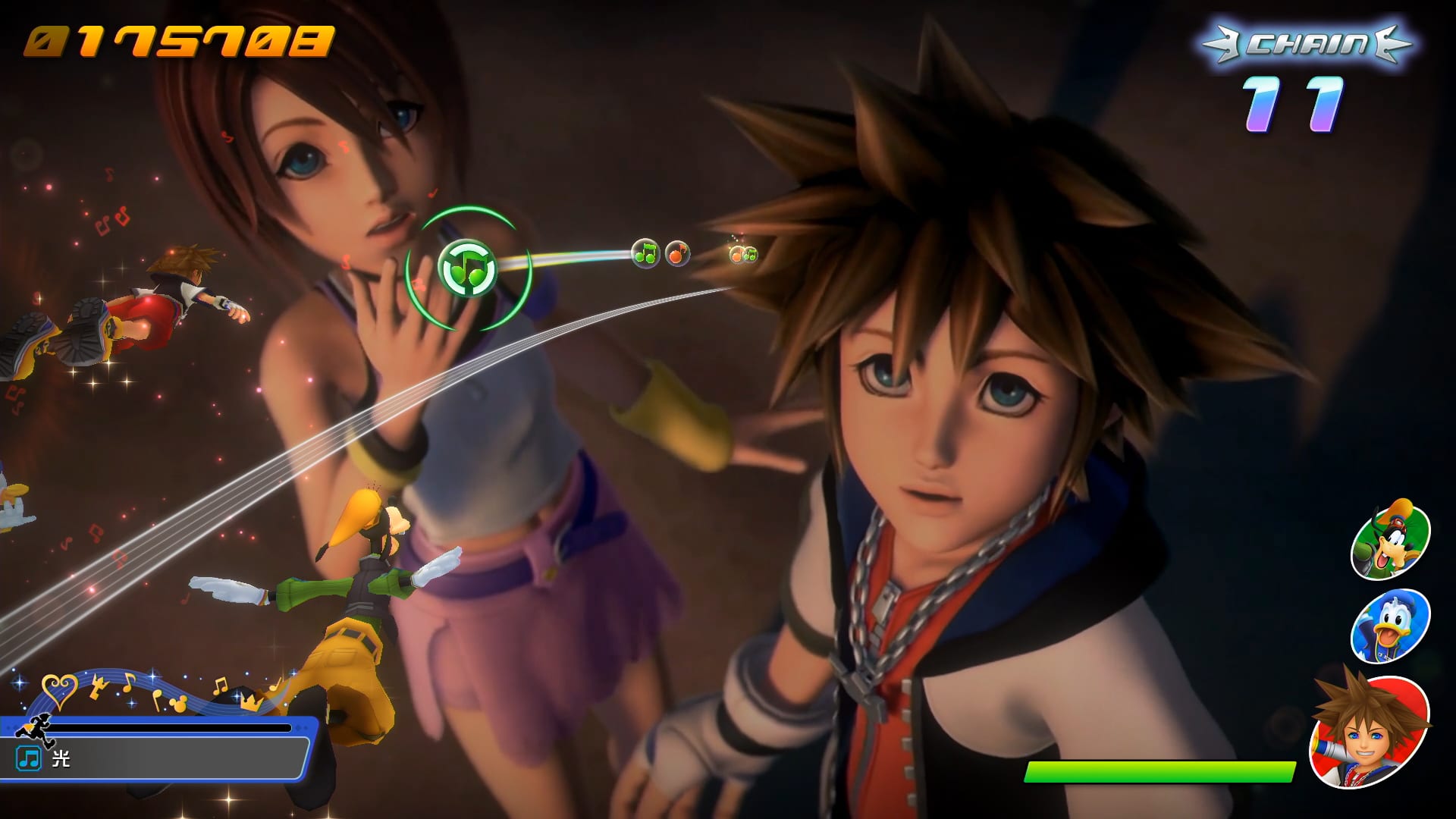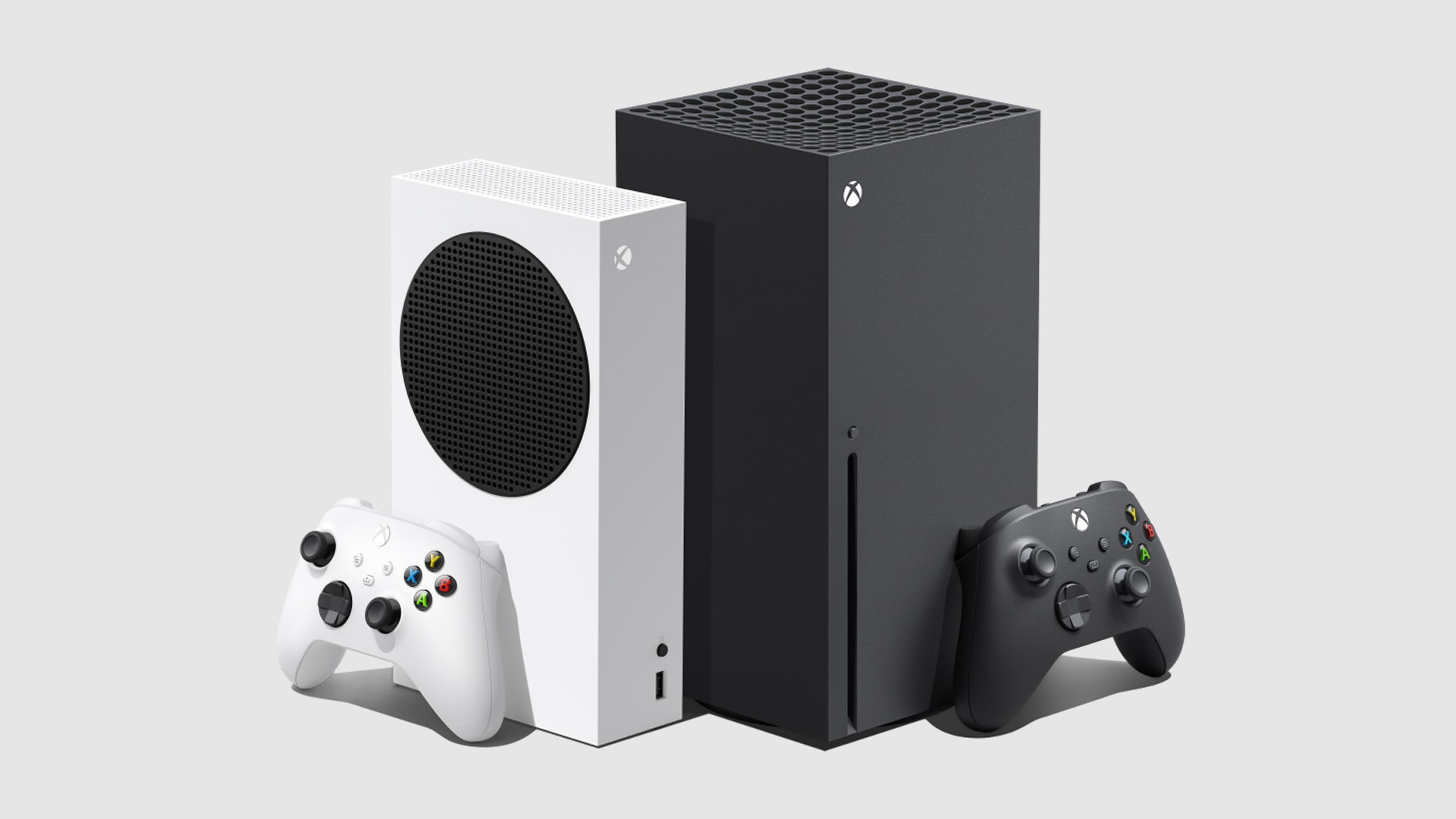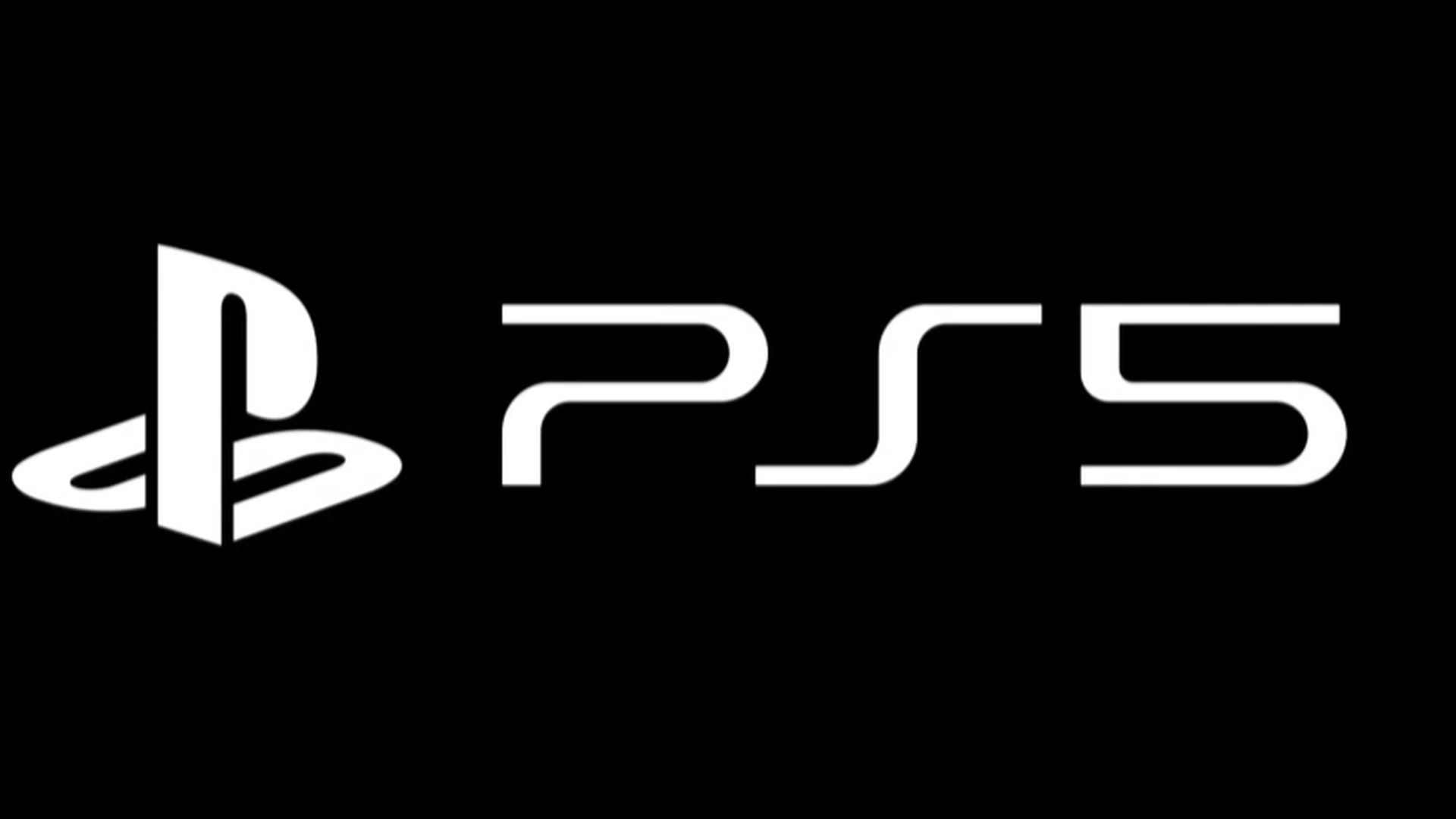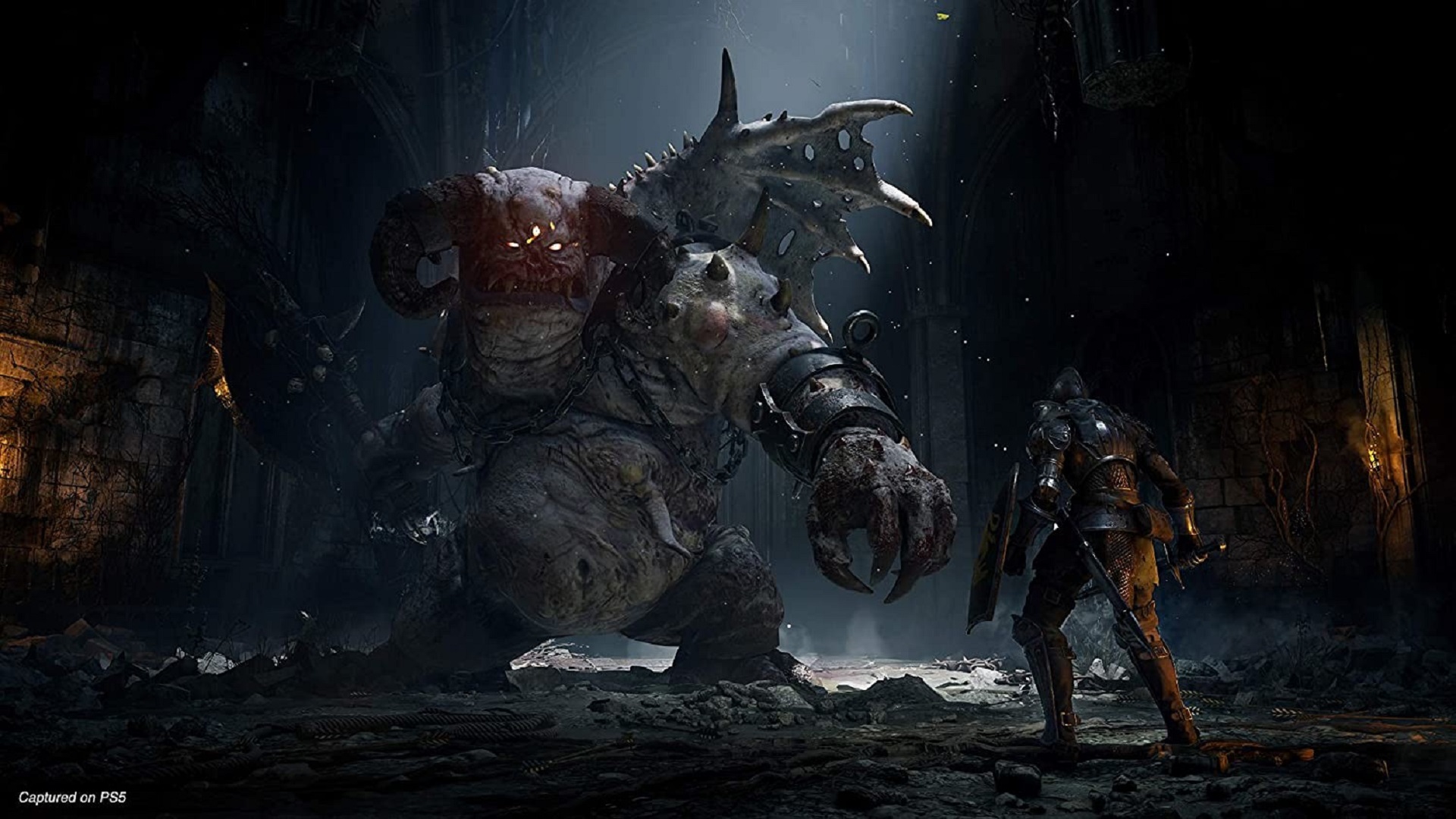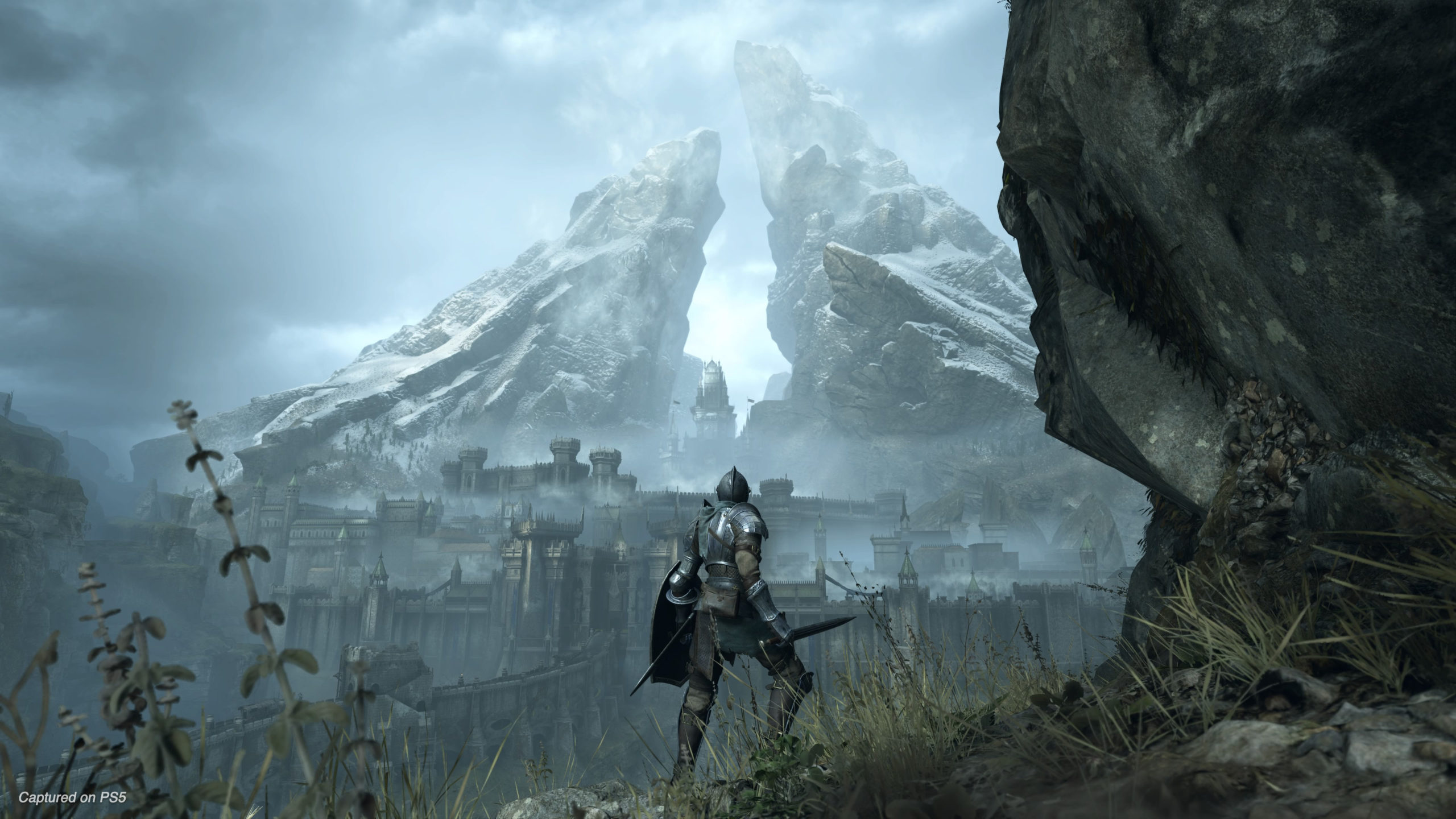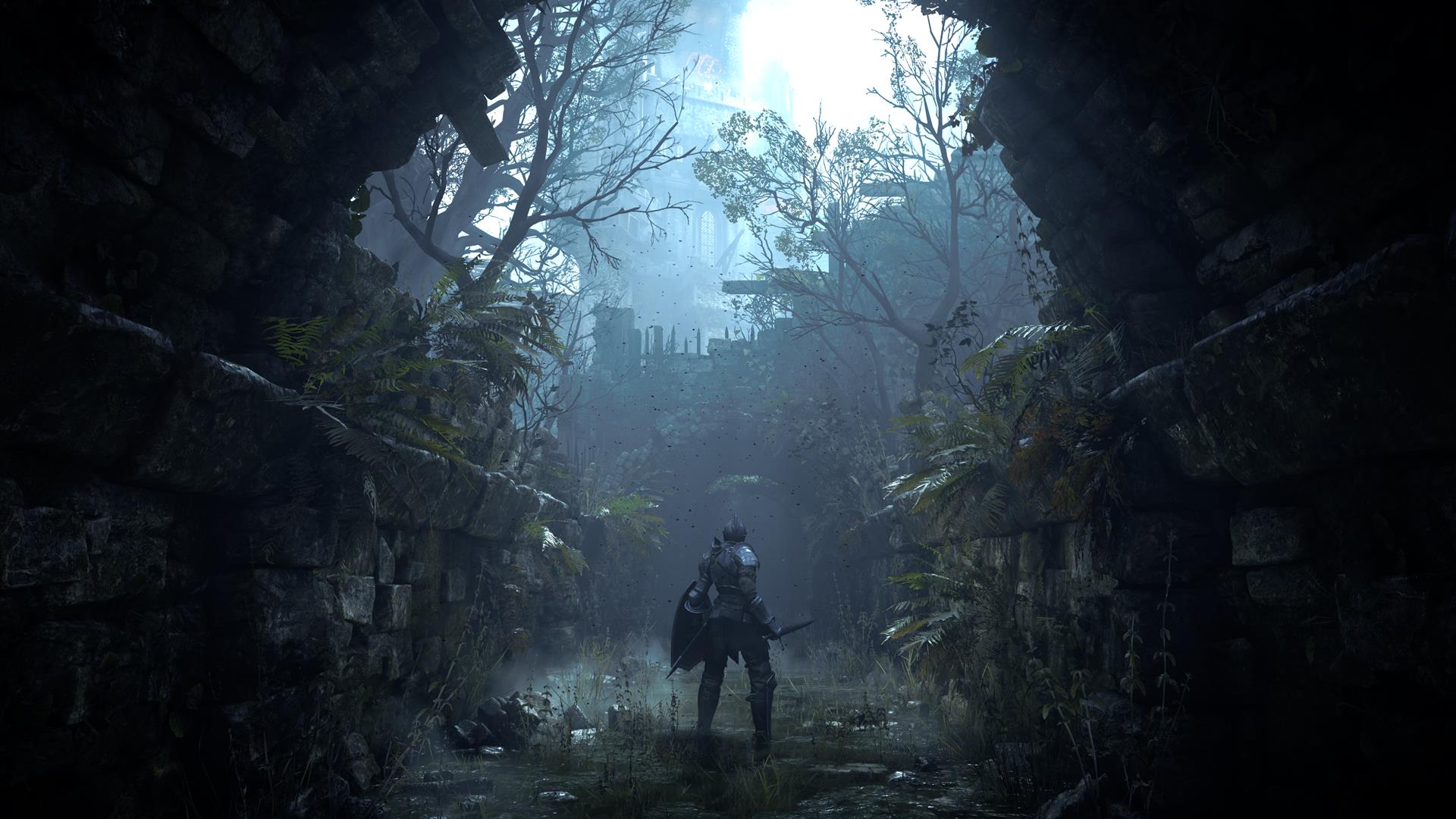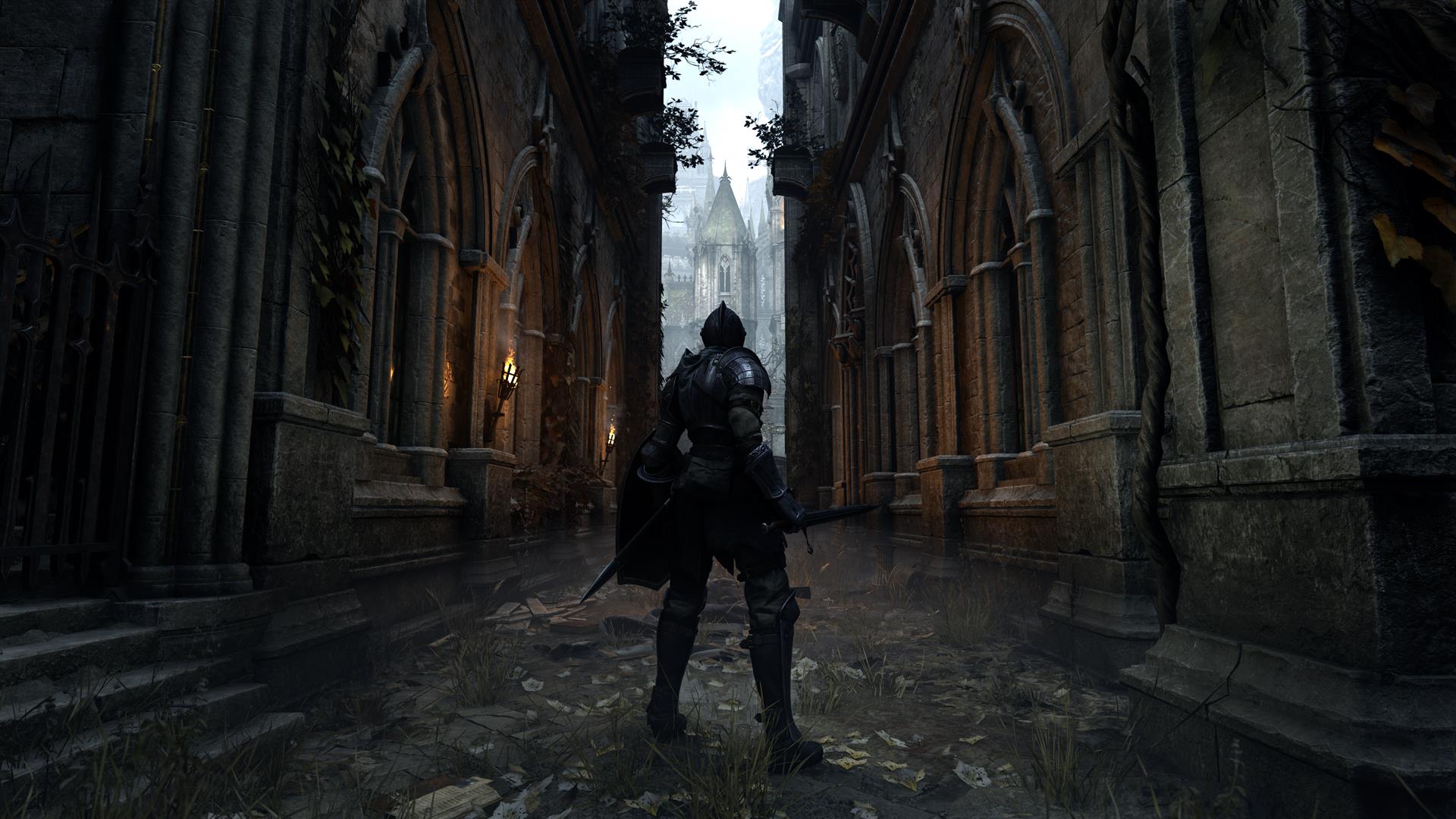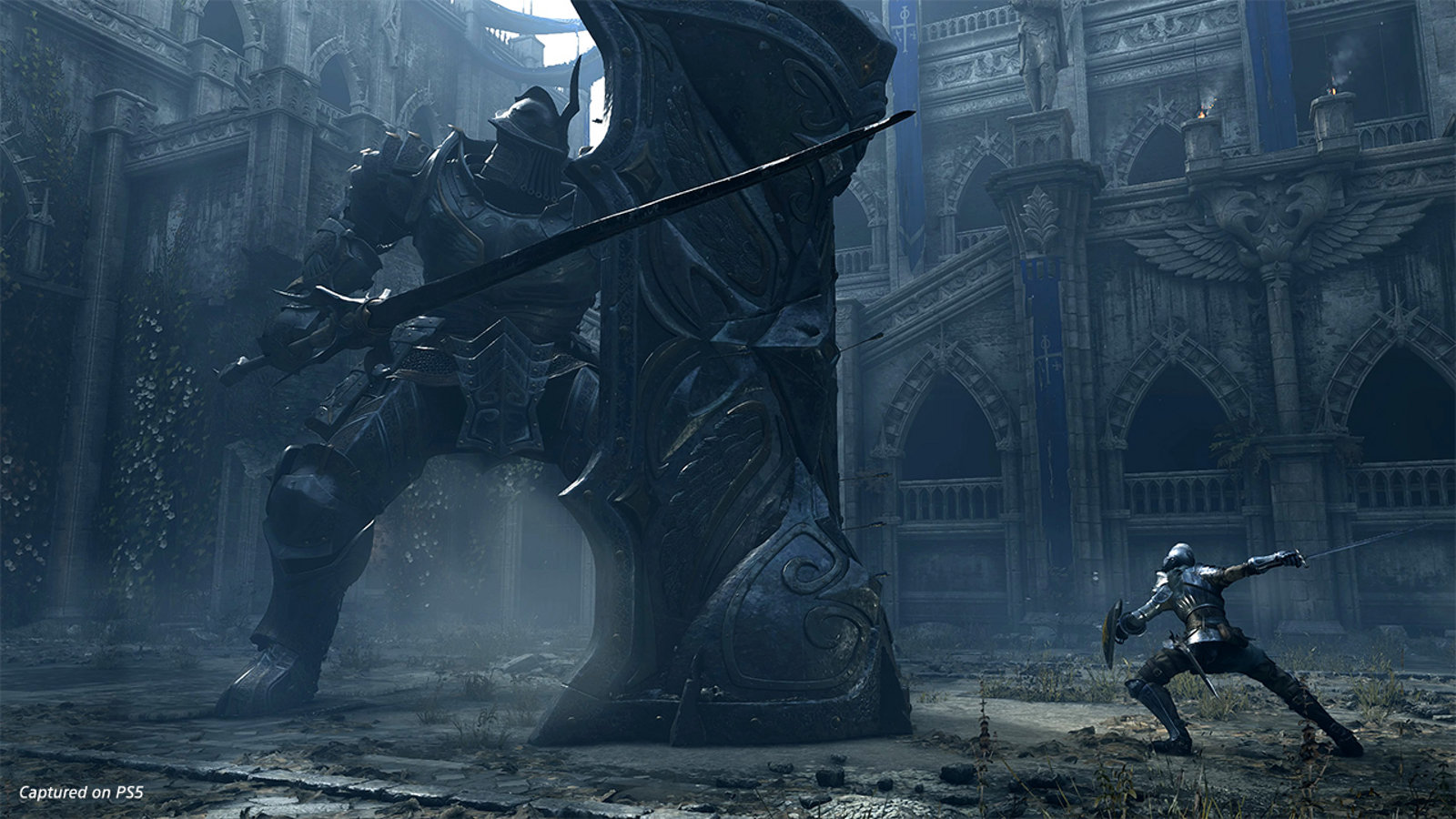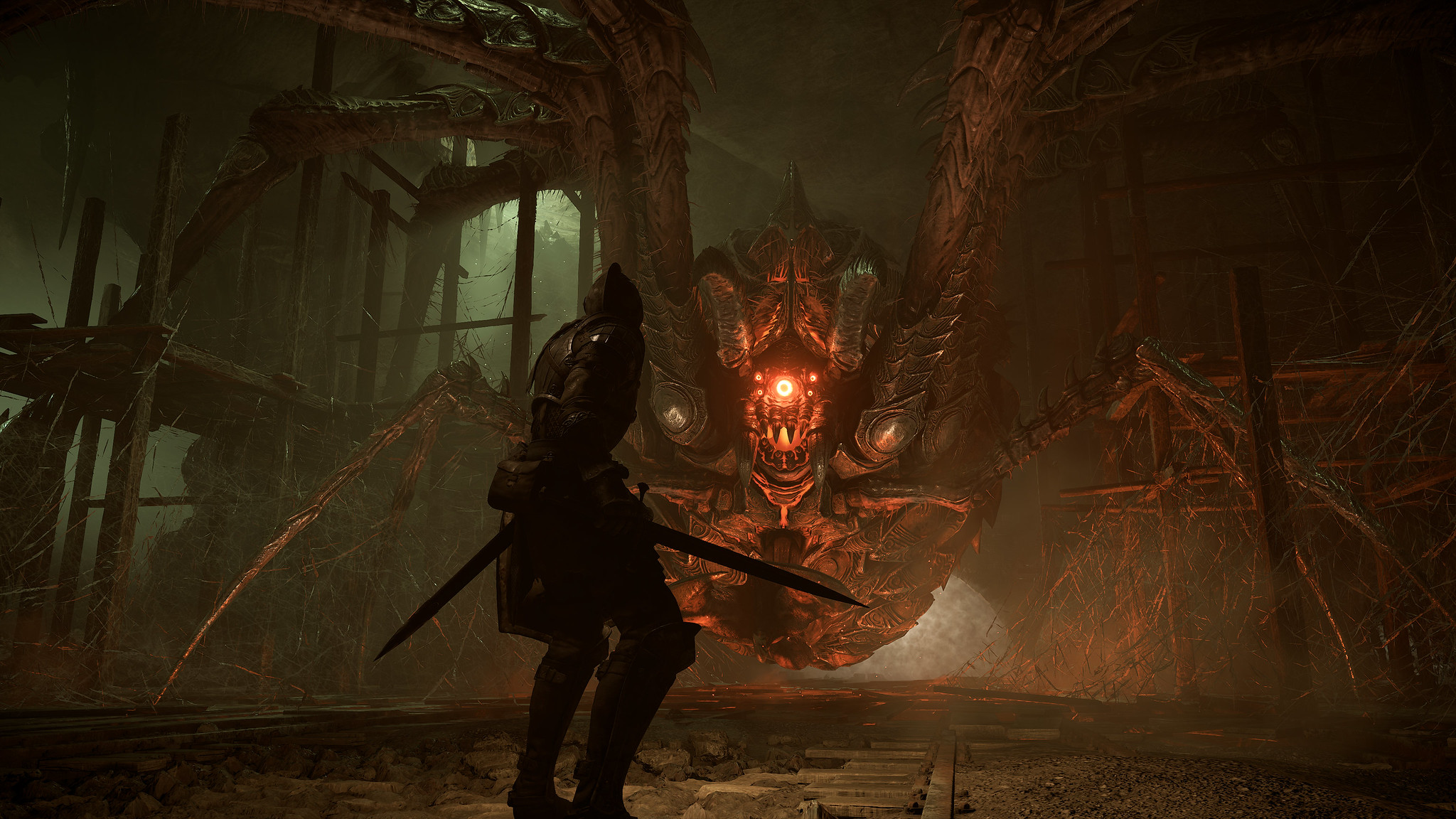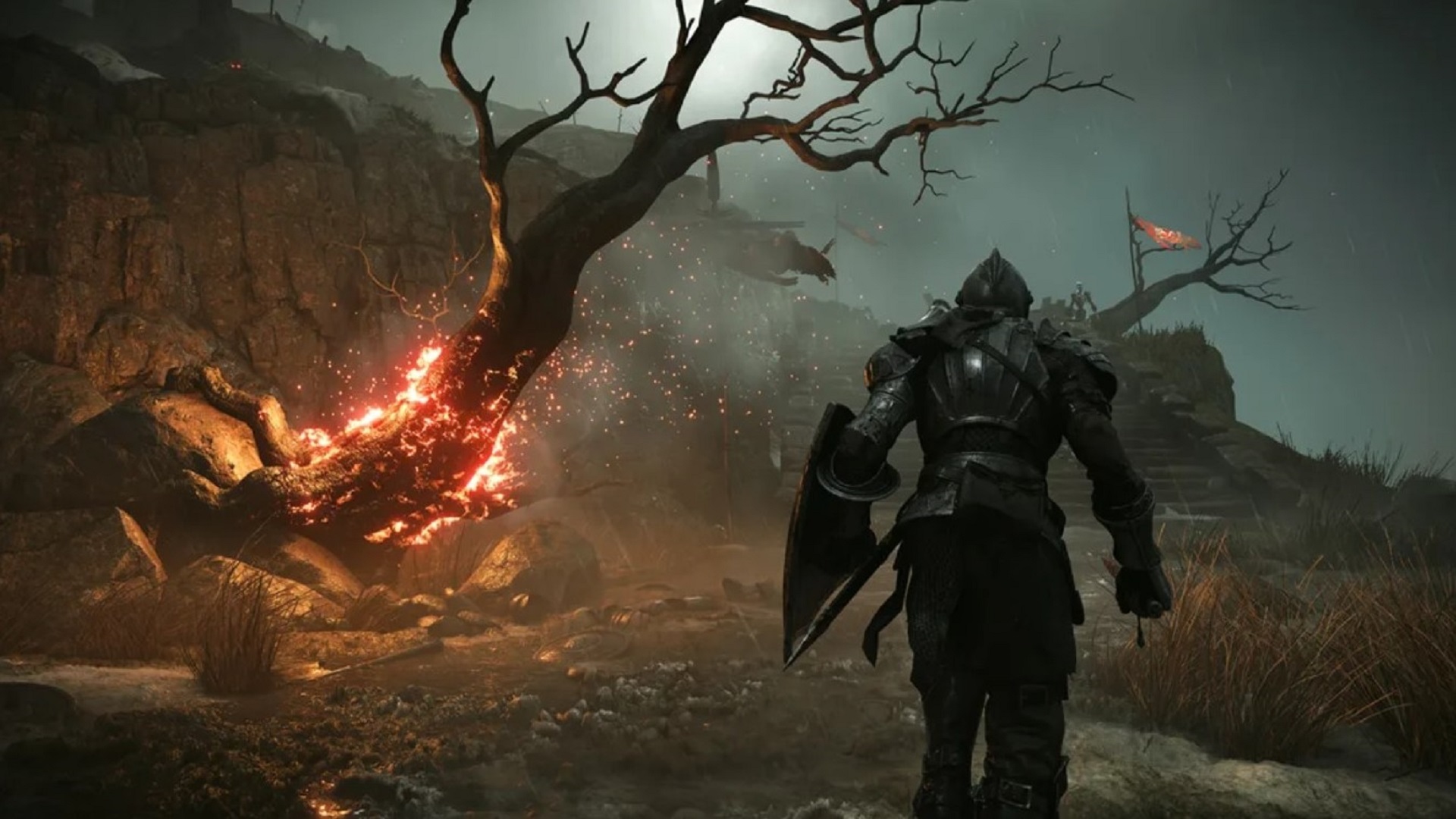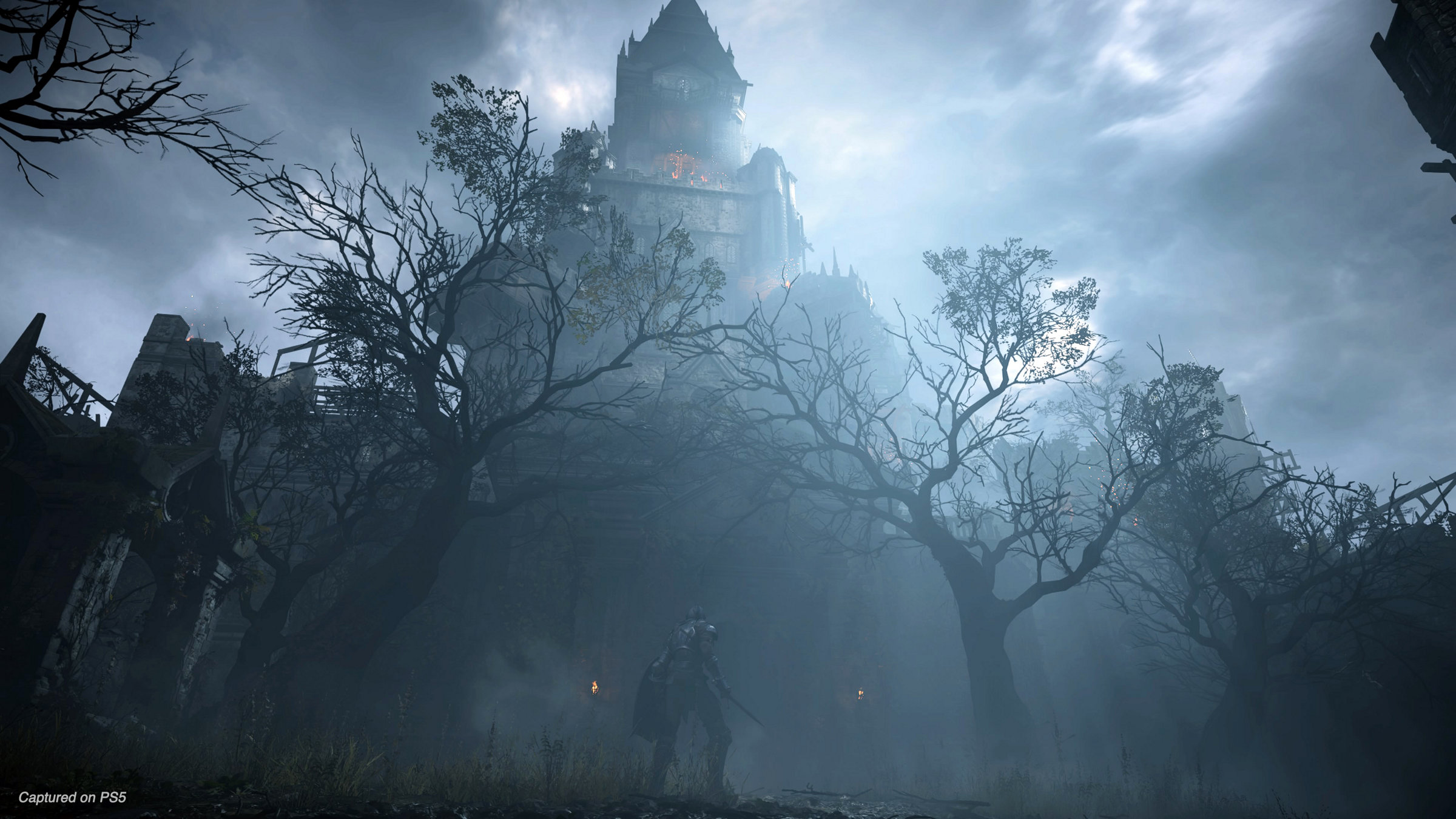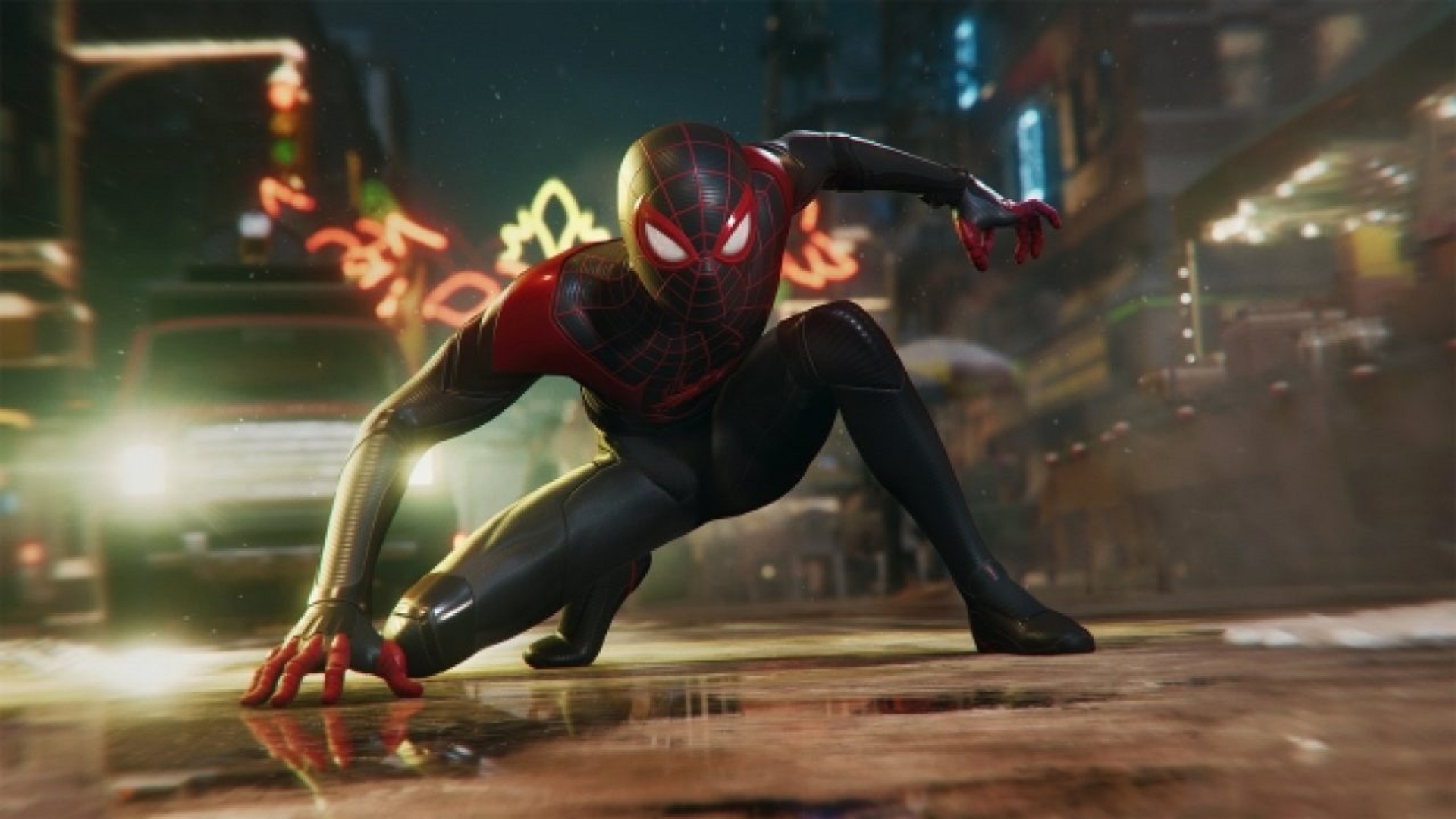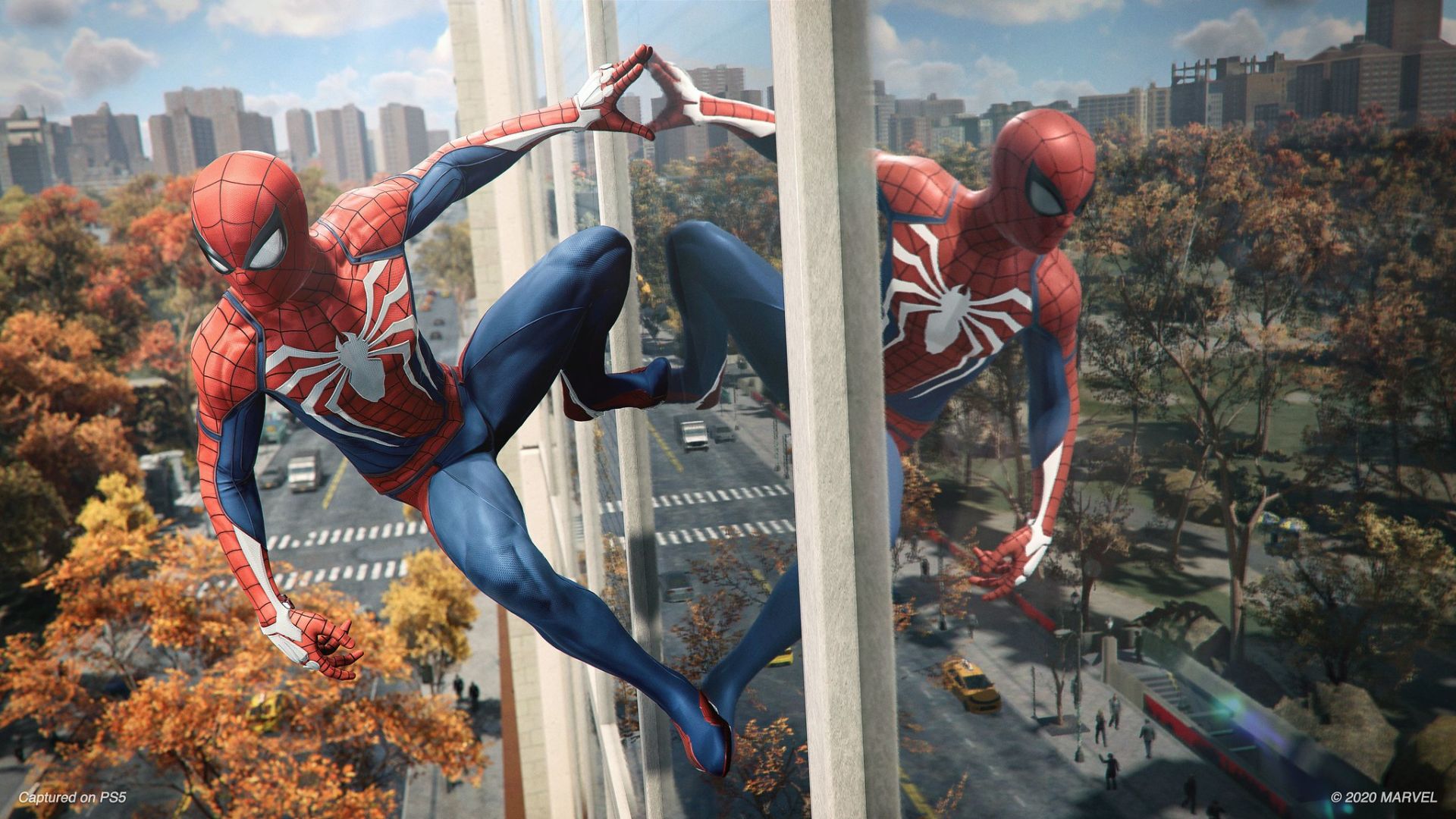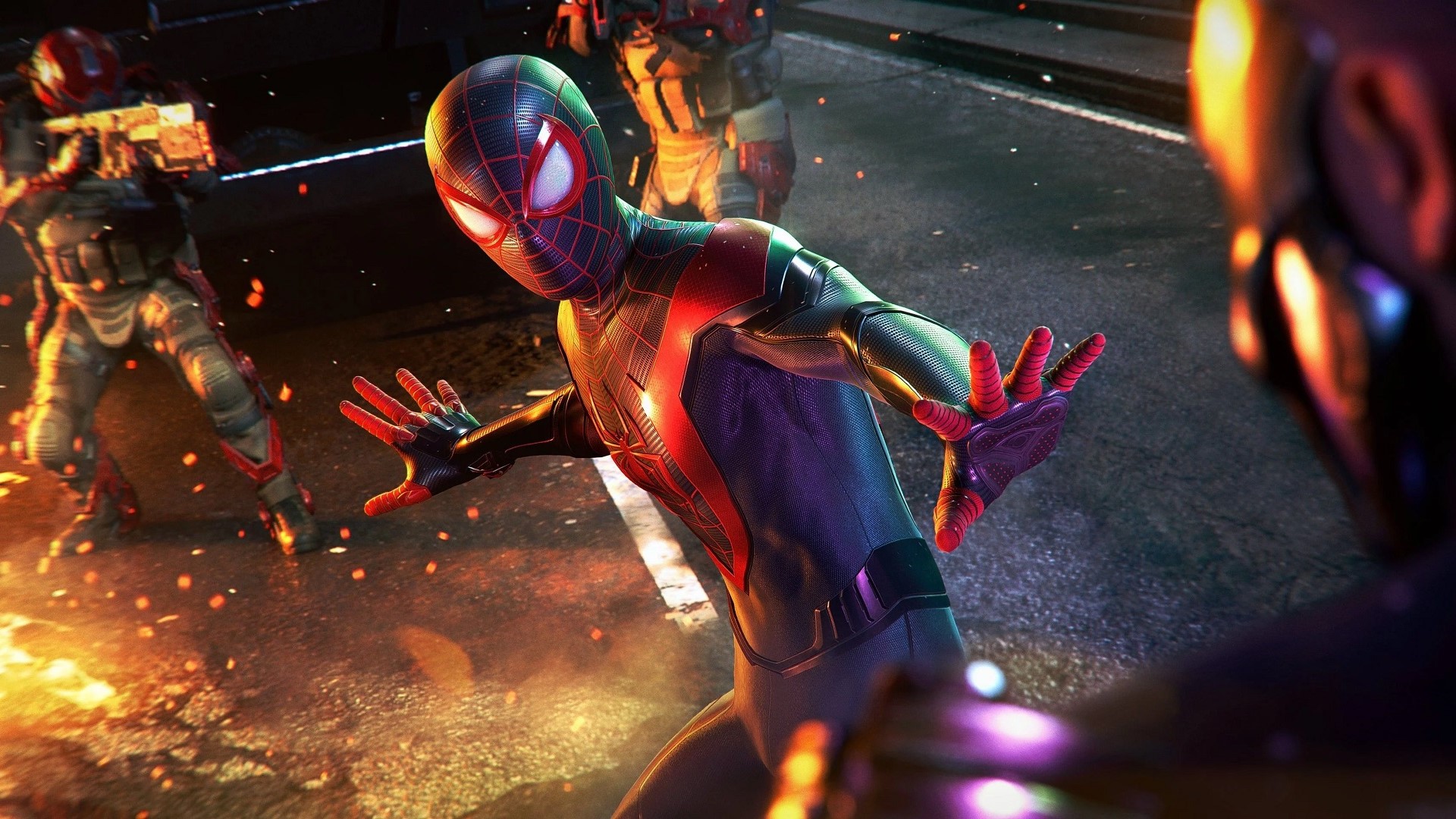The Falconeer Review – Do A Barrell Roll
The thing that struck me the most when I was playing The Falconeer wasn't its striking visuals – which, even on an Xbox One S, stand out as being remarkably pretty, buoyed as they are by a very strong art style – nor was it the game's sheer expanse. It wasn't the compelling lore and backstory for this imaginative world that the game was doling out in bits and pieces, nor was it the actual aerial dogfight action (which we'll get to in a bit). The thing that stood out to me was that all of it – the graphics, the combat, the world and its backstory, everything except for the audio, really – was done by one person. This rather imaginative and expansive aerial dogfight game is the brainchild of one person.
That really does put a lot of things in perspective. The Falconeer has quite a few issues, some small, others rather obstructive, but in the end, that all of this was the work of one person really helps appreciate the game's strengths that much more, while explaining why some of its flaws are the way they are. Games far less impressive have come out of development teams far bigger and better equipped with resources – a game by one person having a few misses can hardly be held against it as much, given that.
"Missions are preceded by an overview of the map of their setting, with characters explaining the history, politics, economy, or whatever other factor will end up being relevant in your coming mission, in voiceovers."
The Falconeer is an aerial combat game. These used to be all the rage not all that long ago, although the genre isn't quite as popular now. Nonetheless, even if it were, The Falconeer would stand out. One part of this comes down to its incredibly imaginative setting, a vast ocean world with tiny dotted islands controlled by warring factions, and all relying on the eponymous falconers to help guard their turf a bit. These falconeers are pilots of some pretty oversized birds, armed with weaponry enough to be able to take on almost anything the sea can throw at them – though they are pilots riding on the back of a bird, which means hits damage you quite a bit too.
The Falconeer is clearly very proud of its setting. Missions are preceded by an overview of the map of their setting, with characters explaining the history, politics, economy, or whatever other factor will end up being relevant in your coming mission, in voiceovers. Each place ends up being defined well, and though you never really see much of them, you start to get a feel for these individual cultures in the world, whether it be an imperial center that can barely keep territories under its rule, owing to being impervious in their own ivory tower, or a fringe trading town, which has to deal with the dual concerns of catching the notice of the empire, and having to fend off against pirates and smugglers. It's an extremely rich setting, and The Falconeer uses it to paint a picture of a world perennially in conflict, with these five factions barely and tenuously hanging on and surviving.
"Unlike almost every other game, no 3D model in this game uses texture mapping of any sort, which means that the objects you see gain their form and look entirely from the in-game lighting. The look ends up being rather unusual, but really immersive and bold, immersing you in the rich world, and adding more substance to it along the way to boot."
It helps that the setting is brought to life by some rather striking visuals. I spoke about the strong art earlier, but what also helps the graphics stand out is the rather unusual rendering techniques that solo developer Tomas Sala has leveraged. Unlike almost every other game, no 3D model in this game uses texture mapping of any sort, which means that the objects you see gain their form and look entirely from the in-game lighting. The look ends up being rather unusual, but really immersive and bold, immersing you in the rich world, and adding more substance to it along the way to boot.
Traversing this world on birdback can feel great – once you finally have a hang for the controls. They're not really difficult to master as far as flying is concerned, and you get a fair degree of customization to further alter them to suit your needs. Everything, from slow dives to accelerating, to flapping in place, to barrel rolls, is easy to pull off, and a sense of zen-like peace and nirvana can almost set in on you when you're just flying around the world, thanks to the rhythm of the controls, and the beauty of the surrounding world. The controls, when flying, feel elegant.
You'll notice I have qualified my praise for the controls by specifying it extends only to the flying controls, and there's a reason for that. For all the elegance that you can experience when flying around, combat feels clumsy and hectic, and not in a good way. Your aiming reticle is mapped to the same analog stick as your turning and movement – not an issue in and of itself. However, the reticle moves extremely slowly relative to your actual movement and turning – extremely slowly.
This becomes an issue, creating a disconnect between your quick and rapid turns and movements, and the extremely slow aiming, meaning that trying to actually fire on target becomes an annoying game of chasing the target across the screen with your slow as molasses reticle in 360 degrees, in an effort to actually land a hit on them. The Falconeer actually tries to make some concessions – you have a target lock on button, for example, as well as a button to reorient yourself with respect to your target instantly. But this scarcely helps when the aiming reticle is still so slow, and when there are so many enemies swarming you from all sides and directions, and when hits can take out a good chunk of your health.
"I can imagine this combat actually feeling great on a PC, where the accuracy and movement of a mouse is far beyond the sluggishness of the analog stick, but at least on console, I can say that the combat was my least favorite part of the whole experience – which is a bit of an issue for a dogfighting game."
Combat is, unfortunately, annoying. I found no way to increase the sensitivity of the aiming reticle in the settings menu (and I tried looking multiple times), which struck me as unfortunate given that The Falconeer otherwise actually tries to accommodate player preferences very well. I can imagine this combat actually feeling great on a PC, where the accuracy and movement of a mouse is far beyond the sluggishness of the analog stick, but at least on console, I can say that the combat was my least favorite part of the whole experience – which is a bit of an issue for a dogfighting game.
I wager this feels better on an Xbox Series X (where the game will run in a blistering 120fps), because, again, that has to help with the reticle movement speed. Unfortunately, on the One S, at least, this meant I was losing battles I had no business losing far too easily, which, because the game does not employ any checkpoints in its missions, meant that I would have to start the whole mission over, from the beginning. No matter how close to the end I was.
These annoyances stand at odds with how peaceful and enjoyable simply exploring the world feels. The world of The Falconeer can look empty, but there's actually a fair bit for you to discover, from locations to lore to an understanding of the geopolitics of the Great Ursee, to even abilities and technology that can aid you in combat. It's a surprisingly rich world, with a lot on offer, and I would argue the world, and simply flying through it on the back of your giant bird, is the best part of the package.
The Falconeer isn't a full-fledged slam dunk, then. However, this brings me back to what I said at the start of this review – in the end, this entire game was made by one person (other than the sound side of things, which is also excellent, incidentally). The flaws become easier to excuse in that context. It also helps that the game is budget prices, meaning there is less pressure on it to live up to justifying the value of the purchase of a full priced game. For the price you pay, The Falconeer has a lot to offer.
It looks gorgeous, its got an intriguing world, and exploring and flying can feel great. The issues with the game's checkpoints and combat unfortunately do drag it down a bit, as does mission design that starts to get repetitive fairly early on – but overall, I walked away from The Falconeer feeling impressed. Xbox players have a fair few good games to choose from at launch, while PC players have no shortage of other (albeit older) flight combat games. But I do hope that Xbox and PC players alike give The Falconeer a good look. It's not a home run, but the things it does well, it does really well – and sometimes, that can be enough.
This game was reviewed on Xbox One.
Godfall Review – An Empty Suit of Armor
Godfall starts at the end of a war between two brothers. The details of how it started are glossed over. The long and short of it is that the big bad, Macros, wants to become a god. Orin – that's you – wants to stop him. The war ends in a duel atop a tall tower overlooking the ocean. Because there has to be a story, Orin loses. But, like all bad guys with aspirations of absolute power, Macros makes a crucial mistake: instead of killing Orin then and there, he smashes him through the stone into the sea.
Naturally, Orin survives. You take control of him sometime later. Macros is on his way to godhood, and Orin has to take him down. Hence, Godfall. It's not an imaginative premise, but Godfall isn't an imaginative game. As I hacked and slashed my way through the game's too-long tutorial, I marveled at how derivative Godfall was. How soulless it felt. How every second I spent playing it reminded me of something else.
" If you've played God of War, you'll know how to do basically everything in Godfall because they play almost exactly the same."
The easiest thing to compare Godfall to is Sony Santa Monica's 2018 reboot/sequel to the God of War series. If you've played God of War, you'll know how to do basically everything in Godfall because they play almost exactly the same. Godfall just does everything worse. There are light and heavy attacks that can be chained into basic combos. There are skill trees to fill out, which upgrade your character and grant new abilities. Each of your two weapons comes with two special abilities that do extra damage. You can press a button to leap over specially marked obstacles and climb designated ledges. Enemies can be killed by either reducing their health to zero, or building up their stun meter, which allows you to execute them.
You have a retractable shield on your left arm that fans out on command so you can block and parry enemy attacks, except for the red ones, which, as in God of War, must be dodged. Pressing down both thumbsticks activates Archon's Fury, which is this game's version of Spartan Rage. Even the control schemes are almost identical.
Godfall's art is similarly derivative. Its art style could be politely described as generic fantasy. A more specific description would be to day it's combination of the art from WarCraft, Darksiders, and God of War. That's not to say that Godfall doesn't look good – it's truly a gorgeous game – but you don't have to squint hard to see where it's taking its cues from, and absolutely nothing about its world or characters feels original.
"The best idea the game has is Soulshatter, which allows you to stack damage on enemies with light attacks before detonating it with heavy attacks."
It would be an understatement to say Godfall doesn't make a good first impression. It's impossible to care about the plot, because while the game clearly wants to lean into its lore, what's here is so generic, poorly written, and filled with proper nouns that it impossible to follow beyond broad strokes. The same is true of the game's characters. Orin is a cardboard cutout, and the supporting cast isn't any better. Each of them communicates in dialogue that touches on one of the three things that character cares about and nothing else.
But, like all games of this type, you're not here for the story. You're here to play it. And here, Godfall is fine. Not good, not bad. Fine. After you unlock some skills, Godfall's combat begins to open up. You can access to moves that require you to time specific attacks, opening up your combo possibilities, special attacks that stun or do area damage, and the like, and it makes Godfall's take on the light/heavy paradigm that seems to dominate every modern action game enjoyable, if not particularly original.
The best idea the game has is Soulshatter, which allows you to stack damage on enemies with light attacks before detonating it with heavy attacks. The game also incentivizes risk by giving enemies powerful attacks that glow purple. These attacks hit hard but, if parried, leave the enemy stunned, allowing you to pour on the damage. Both of these systems incentivize you to take risks in combat and make the core systems feel more interesting than they'd be otherwise. To Godfall's credit, the combat does improve once you have some new skills to make it interesting. It's never great, but it is good enough to be compelling.
Godfall is the latest take on the loot genre – the developers describe it as a looter slasher – so killing enemies gives you loot, ranging from new weapons to rings and banners that provide stat bonuses. Like in World of WarCraft, all of this is color-coded from uncommon (white) to legendary (orange), and like in Word of WarCraft, the goal is to make your numbers go up until they are the best numbers in all the land. There's a certain amount of personal preference here, especially when it comes to the weapons, which include longsword, great swords, war hammers, dual blades, pole arms and the like. Each weapon type has its own combos, timings, and special moves, so your choice matters. I liked all of the weapon types, but I was partially to longswords, great swords, and war hammers. The former are good all arounders while the latter two deal heavy damage to anyone unlucky enough to be in your way.
"Godfall absolutely bombards you with loot. Most of it is useless and you'll only look at it long enough to scrap into resources you can spend to upgrade the stuff you like, but you'll still spend a lot of time sorting through it."
Finding out what you like is important because Godfall absolutely bombards you with loot. Most of it is useless and you'll only look at it long enough to scrap into resources you can spend to upgrade the stuff you like, but you'll still spend a lot of time sorting through it. Most of the loot comes with secondary stats, or buffs effects like Bleed, which do damage over time, but Godfall is really bad at showing you what these effects look like in game. Mostly enemies change color, but it's not always obvious what the different colors mean, so pure damage is probably your best bet.
Upgrading is done at the Sanctum, which is where you can also spend resources to by new Valorplates. Valorplates are the game's version of armor, but they don't actually seem to have a huge impact on your stats. What does change are your passive stats and the properties of your Archon's Fury. Some summon friends to help you out, while others cause status effects and boost your damage. It's not a huge deal, but it's an extra set of customizations to play with. Interestingly, Orin takes on the appearance and voice associated with the Valorplate he's wearing, so he can be either male or female depending on which one you choose.
When you're not in the Sanctum, you'll be out exploring the different areas. One's a big forest that surrounds several constructs, another one seems to be underwater, and so on. These areas are large and open, which is good, since you'll return to each of them several times to complete the various main and side missions. While I typically dislike backtracking, it largely didn't bother me here… until it came to boss fights. These encounters require you to unlock them by gathering items you collect during certain missions, which can be a bit annoying and ruin the game's pacing. It's irritating to be told that you can go fight a boss only to have to spend the next half hour or so unlocking that boss. The boss fights themselves are a lot of fun (and the game is generous with mid-boss fight checkpoints), but it's a shame that Godfall puts extra steps between you and the fun.
"almost everything about Godfall is aggressively mediocre and incredibly derivative."
The one area of Godfall that deserves unreserved praise is the game's visual design. The aesthetic may be generic fantasy, but the game is gorgeous and runs extremely well. I ran it at 1080p and a largely stable 60 FPS at maximum settings with a RTX 2060 Super and an i5-6600K. The only performance issues I noticed were the odd stutter where the game seemed to skip ahead a few seconds. It was jarring when it happened, but rare enough that it didn't bother me.
Godfall does support three player co-op, which can make even the worst games more fun, but since there doesn't seem to be any matchmaking and friends must be invited directly, I was unable to test it.
Godfall is a difficult game to review. On the one hand, the combat gets pretty good if you give the game time to find its feet. On the other, almost everything about Godfall is so aggressively mediocre and incredibly derivative. It's one thing to have a bad game that tries something new and fails. It's another thing to have a game that doesn't try anything new and seems to revel in its mediocrity. That's the kind of game Godfall is. The combat is solid, but nothing about this game stands out. Its world and characters are boring, the game systems are blatantly lifted from other, better games, and its loot system seems to have no idea what to do but shower you in rewards and hope you like some of them.
Godfall is the kind of game that releases at the beginning of each generation: it looks and sounds good, but there's nothing special about it. The combat can be fun, but the game as a whole is mediocre. If you're looking to hack n' slash your way through a fairly generic fantasy world and grab some loot along the way, then perhaps Godfall's faults won't bother you. But everyone else will see Godfall for what it is: something people buy to pass the time and show off their new graphics card or console and forget about once something better comes along. And like Godfall itself, that's fine – but nothing more.
This game was reviewed on the PC.
Let's Take A Minute To Appreciate That Sony And Microsoft Managed To Launch New Consoles This Year
Sony and Microsoft have now both launched their next generation consoles, hitting – for most markets – that Holiday 2020 release date that both committed to, and refused to budge from. Inevitably, the next five to seven years of console gaming will be dictated by these two machines, and I think I speak for everyone when I say, we are all excited to see how video games evolve as a medium thanks to the immense new potential for player and creator expression that the PS5 and Xbox Series X | S bring to the table.
But while it's exciting to look ahead, I do think we should also stop and take stock of where we are right now, and how we got here. Console launches are an extremely complicated process – there are dozens upon dozens of moving pieces, with multiple logistically challenging issues companies must overcome to ensure there are no disruptions to the supply chain. From designing and developing the hardware, to coordinating with third parties (especially for launch games), to coordinating with your own internal studios, marketing, manufacturing, quality assurance and testing, retailer outreach, and shipping millions of units across the world for a coordinated launch – this is truly a very involved and complex process.
That is the reason you never see a "perfect" console launch, why the launch of a new system is always marred by some lapse or the other, whether it be supply shortages, or shortages of accessories and games, or publicized hardware failures, delays of launch games, or even just consoles launching with much more limited functionality than their predecessors had managed to build up to over the course of their lifespans. At the best of times, console launches can be nightmarish to coordinate
2020 is not the best of times. The onset of the COVID-19 pandemic has thrown an unprecedented wrench into almost every part of the supply chain – manufacturing is affected, shipping is affected, retail is affected, even marketing has had to be hastily improvised on the fly, in the absence of those glitzy, glamorous, and grand launch events that consoles typically have. The challenges of even managing supply for existing hardware in a COVID world are so immense – just look at the ongoing shortages for the Nintendo Switch every single month, in spite of Nintendo manufacturing and providing more units of it than any other console has received in history other than the Wii – that honestly, a delay to next year would have been understandable. People would, of course, have been disappointed, but given COVID, everyone would get why the consoles had been delayed (well, mostly everybody. I'm sure some lunatics somewhere would have taken up their pitchforks and sent death threats to Sony and Microsoft, like the well adjusted individuals that they are).
The truly impressive thing here is that Sony and Microsoft didn't budge – they launched their consoles in the middle of this pandemic, in the middle of the largest disruption that the global supply chain has ever seen. And to be clear, these console launches are in and of themselves significantly more complex than, say, the Xbox One and PS4 launches. Both consoles have two SKUs each, which means double the coordination needed for R&D, manufacturing, marketing, and retail.
Another thing that deserves a shout out is how generally stable these new machines seem to be at launch. While launch hardware always has more problems than the hardware that follows – remember the wobbling launch PS4s, or the self-scratching Switch docks? – right now, the PS5 and Xbox Series X seem to be remarkably devoid of any large scale issues or errors cropping up. Sure, we've had some isolated reports of Xbox Series X and PlayStation 5 consoles bricking, but there's no widespread epidemic of hardware or software failures, which has typically been characteristic of every new console launch. That Sony and Microsoft managed to coordinate QA this good, across two SKUs each, in an environment that places significant restrictions on what they can and cannot do, speaks wonders to just how much effort must have gone into ensuring these consoles launch, and that they launch well.
There, obviously, are a few issues – supply is, predictably, extremely limited (meaning scalpers are having a field day, and it's not even clear if it will be possible for someone to walk into a store and get a new console for themselves this year), for example; Xbox Series X has launched without any major flagship game (or really, any "launch game" in the traditional sense), with COVID having delayed the development of Halo Infinite, which was originally planned to be the big headlining title for the console. PS5 owners are reporting minor bugs, such as their controllers not charging from certain USB ports. But there is nothing even remotely on the same level as, for example, the Switch docks that were scratching their screens.
I know how some of video game audiences are, so I know that expecting people to put their console warring to the side and just enjoy their games and the success of the medium is a long shot. I know in the coming years, Xbox and PlayStation are going to be run through the ringer, and compared on every possible conceivable (and inconceivable) metric there is (with some Nintendo thrown in there for good measure to boot). And, sure, the PS5 and Xbox Series X are going to be the champions of the next round of console wars, because that is a thing, unfortunately – but before we inevitably get to that, I just think we can – and should – take a little bit to put that bias aside, and just appreciate the fact that Sony and Microsoft have both managed to pull off more complex than usual console launches in the middle of an unprecedented global crisis – and that they have managed to do it better than most console launches have been in the past.
So congratulations to PlayStation and Xbox, and thank you for bringing us all a sorely needed respite this year, at a time when it would have been easy, acceptable, and, even expected, that things would get delayed. May this be indicative of an upcoming smooth and successful generation of games, in which all players and platforms thrive alike.
Note: The views expressed in this article are those of the author and do not necessarily represent the views of, and should not be attributed to, GamingBolt as an organization.
The Pathless Review – Hypnotic
While playing The Pathless, I was constantly reminded of some of the best, most arresting games I've ever played- Journey, Shadow of the Colossus, The Legend of Zelda: Breath of the Wild. Like those games, The Pathless has a serene, desolate quality to its beauty. Like those games, it builds up a mystical world through a mostly wordless narrative, with just the right amount of lore drops and storytelling. Like those games, it puts its focus almost entirely on organic exploration and puzzles, not on combat. And like those games, The Pathless is an experience I'm unlikely to forget about anytime soon.
You play as the Hunter, a master archer who's taken it upon herself to rid the land of a decaying corrupted inflicted upon it by an evil, ominous entity known as the Godslayer. The Eagle Mother, the land's guardian spirit, was defeated in battle by the Godslayer, and her children, guardians of different areas of the game's world, have become corrupted and are in thrall of the entity. Accompanied by a reborn avatar of the Eagle Mother, the Hunter has to travel across the land to free the spirits of the guardians, and ultimately defeat the Godslayer to rid the world of his corruption.
"The Pathless is an experience I'm unlikely to forget about anytime soon."
The narrative setup is a simple one, and the story itself isn't particularly unique, but The Pathless tells it quite effectively. There isn't much of a focus on active storytelling, with only a handful of cutscenes interspersed throughout the story, and most of the lore and backstory is handed to you via accounts and text boxes that you find scattered throughout the world. What you do find is captivating enough though, and creates an aura of mystery that elevates the narrative and the game's world to solid heights.
The focus, however, is very much on gameplay, most of which revolves around an accessible yet incredible traversal system. By holding down the left trigger, the Hunter begins sprinting, which drains a stamina meter, and shooting emblems scattered throughout the world refills the stamina meter, and with the right timing, can provide a speed boost or launch you higher in the air if they're shot while you're airborne. Meanwhile, your eagle companion can also help you hover, and depending on how much you've upgraded your abilities, flap its wings a number of times to take you to greater heights.
Shooting the emblems is a mostly automatic process, and the game automatically locks you on to them, saving you the act of manual aiming, and instead letting you focus on speed and placement. The traversal system is one that's easy to get into, but holds just enough of a skill cap. Combining your abilities with your eagle's to chain together multiple dashes, glides, and jumps can take some getting used to, but pulling off these combos and watching the Hunter flit through the world at incredible speeds feels incredible. Thanks to this fast, fluid, and speedy traversal system, the simple act of moving about in the world of The Pathless is an absolute treat.
"Thanks to its fast, fluid, and speedy traversal system, the simple act of moving about in the world of The Pathless is an absolute treat."
Besides traversal, exploration and environmental puzzle solving are what will define your time with The Pathless. There's hardly any combat in this game, with your bow mostly used for moving around and solving puzzles. Your path forward in every new area of the world is activating a number of obelisks, for which you require Lightstones, and these Lightstones are found by exploring the world and solving environmental puzzles.
Exploration is organic and pulls you right into the game's world. There's no map, no markers, no compass, and you're instead made to rely on visual navigation as you look for points of interest in the world from vantage points or using your Spirit Vision ability (which is what The Pathless calls Eagle Vision, or Detective Vision, or Witcher Vision, or whatever you want to call it), which highlights points of interest in a red hue from a distance.
This diegetic style of exploration is what gives The Pathless its name. Much of your time is spent wandering about the world looking for visual cues to follow, and while you're never quite sure what exactly you'll find when you get to your intended destination, the reward is always worth it, without exception- whether its a puzzle to solve, a spectacular sight to see, orbs to collect as you work toward your eagle's next upgrade, or more.
"Much of your time is spent wandering about the world looking for visual cues to follow, and while you're never quite sure what exactly you'll find when you get to your intended destination, the reward is always worth it, without exception."
Exploration in The Pathless always strikes the perfect balance between aimless and being directed- I mostly never knew what exactly I was looking for, but coming up my next discovery always felt rewarding. It helps that the game's world is an absolutely beautiful one. Like Shadow of the Colossus or Journey, The Pathless' world is sparsely populated, and consistently and desolately beautiful. Ancient structures stand out and beckon you forward from distances as you survey the land from heights, and beautiful landscapes and vistas are plentiful.
Puzzles in the game are also very well designed. Like its story or its exploration or much else in the game, puzzles have no tutorials or handholding, and rely simply on visual and diegetic cues. As you explore the world, you'll come across various mini-dungeons, where you'll be tasked with taking on satisfying brain-teasers, tasking you with everything from lining up rings to shoot and thread arrows through to using your eagle to drop blocks onto buttons to open new paths forward. Not once did I come across a puzzle in The Pathless that I did not enjoy figuring out and taking on.
Where The Pathless does stumble is in your encounters with the corrupted forms of each area's guardian spirit. These corrupted beasts move about their designated parts of the game's world dynamically, and if you get caught in their sphere of influence, you trigger a sequence where you have to avoid being noticed by them and stealthily make your way back to your eagle. In theory, they sound great, but really, all they do is get in the way of the real fun, which comes from exploration and puzzles. These sections also almost always play out the exact same way, and end up repetitive pretty quickly.
"Like Shadow of the Colossus or Journey, The Pathless' world is sparsely populated, and consistently and desolately beautiful."
Once you've activated all the obelisks in an area, you take on that area's corrupted beast in multi-stage set-piece boss encounters- which, too, are a mixed bag. The chase sequences that kick them off are thrilling sections, accompanied by wonderfully swelling music and the thrill of of The Pathless' excellent traversal system put to great use, while the head-on combat in the subsequent stages can also be a fun ride, since it feels less like combat and more like fast-paced puzzle-solving. That said, the penalties for getting hit or failing to land a shot in The Pathless are negligible – you can't really die – so these sections end up feeling a bit blunted.
It's a good thing that these sections are few and far between. Like any good game, The Pathless knows where its biggest strengths lie, and it constantly leverages those strengths to craft a hypnotic, rhythmic, beautiful, and captivating adventure. Running through its main story takes less than ten hours, depending on how you play, but I wager I'll be spending a lot more time exploring its world and taking on the activities that I blew past on my way to the credits. The Pathless is a beautiful game, and one that nobody should miss out on.
This game was reviewed on a PlayStation 4.
Kingdom Hearts: Melody of Memory Review – Flavor of Life
A rhythm game using Kingdom Hearts series' most iconic songs is a no-brainer. There's a rich catalog of vocal tracks, background music and battle music to draw from, especially given the series' history. So even if it had to happen on the cusp of a new generation, Kingdom Hearts: Melody of Memory is here and pretty good overall. As with many of its titles over the past few years though, there are a few nags here and there, starting with the story.
Yes, Kingdom Hearts: Melody of Memory isn't just a rhythmic action game. It recollects key moments in the Dark Seeker Saga, like a trip down memory lane with the music softening some of the more inane plot twists (and I mean that in the best possible way).
"Kairi's story serves as an epilogue and ultimately a transition to whatever the next game has to offer. Nothing more, nothing less."
However, it's also a sequel to Kingdom Hearts 3: ReMind with Kairi searching through her memories to ultimately lead her to Sora. The overall coalescing of these two themes isn't as jumbled as you might think but this isn't a climactic finale on the level of the mainline games. Kairi's story serves as an epilogue and ultimately a transition to whatever the next game has to offer. Nothing more, nothing less.
And that's perfectly fine because it keeps the focus on the rhythmic gameplay. Melody of Memory sees you choosing a team and venturing to different locations in World Tour mode, each having their own stages and objectives. The majority of them consist of Field Battles where your team runs down a track, battling various Heartless, Nobodies and so on to the beat. You can equip different items to restore health at key moments, increase item drop rate and XP gain, and even summon King Mickey to act as a fourth party member. Teams can be leveled up for increased stats while leveling the item merchant will unlock new recipes.
"The design of each beat map is also incredibly pinpoint, matching the song's rhythm while providing some unique challenges."
Attacking a singular enemy is easy enough – simply press X on the PS4 controller, for example – but there are moments where two or three enemies must be attacked simultaneously. At this point, you default to pressing L1 and R1 or L1, R1 and X together. Jumping over enemy projectiles with Circle, which is also used to eliminate mid-air threats, or hitting Triangle to unleash magic against larger foes are also a thing. Some Disney-based stages also throw in a guest character like Hercules, Beast or Mulan, and while they don't really add much in terms of unique abilities, they do provide bonuses when hitting certain beats in the tracks.
World Tour kicks off in very modest fashion but as you progress, it starts throwing tougher beat maps at you. This is where the game shines though – from Destiny Islands to Olympus Coliseum or the upbeat tones of The Promised Beginning to the somber End of the World, Kingdom Hearts still offers some of the absolute best music in gaming. The selection here is top-notch, deftly evoking the emotion and nostalgia of key story arcs.
Utada Hikaru's tracks, namely Simple and Clean, Sanctuary and Don't Think Twice, are also included along with classic Disney riffs like Under the Sea and Let It Go. The design of each beat map is also incredibly pinpoint, matching the song's rhythm while providing some unique challenges. Perhaps the only real criticism of the stages is their backgrounds – they can be fairly repetitive. Some, like the Steamboat Willie stage, are the exception rather than the rule.
"The graphics quality throughout can also be uneven. While the general art direction for the series' various titles is good, several environmental aspects and cutscene characters look a bit rough."
Boss Battles are also here, though they work in slightly different fashion. You're essentially dealing damage and guarding against enemy attacks, both determined by the precision of your inputs. There's more variety to be had though, with long presses and directional presses with the joysticks on top of the usual controls. Overall, they're fine but don't really capture some of the more climactic moments from certain fights. Remember when Sora and Riku deflected the dome of lasers created by Xemnas in Kingdom Hearts 2? Or the flying shoot 'em up section? Neither are here. While Square Enix and indieszero didn't have to bring these kinds of set pieces into all of the stages, a few mix-ups in the boss fights – which are few enough as is – would have been great.
The graphics quality throughout can also be uneven. While the general art direction for the series' various titles is good, several environmental aspects and cutscene characters look a bit rough. Also, oddly enough, certain cutscenes (like from 358/2 Days) look slightly worse than expected, either due to compression or some other issue. Some may also take issue with many finer plot points of the saga – – like the interactions between the main cast and Disney characters – but the various cutscenes do their job well enough. But it goes without saying that this is a mere substitute for experiencing the series first-hand and the complete omission of any Final Fantasy characters feels wrong, especially given how significantly they contributed to earlier titles.
Each stage offers different objectives to complete, which can range from defeating a certain number of enemies to hitting every barrel and box available. Some require completing different conditions in Proud Mode (which ups the number of inputs and damage received) or defeating a cumulative number of foes. Completing objectives contributes to unlocking stars to progress forward but you don't need to do everything to finish the main story. They do add to the replay value though, especially when dropping materials for crafting different items like Concept Art, Profile Icons and additional Memory Dives.
"It might be niche in many aspects but serves as a stellar recap of the saga's most iconic moments."
Speaking of Memory Dives, they'll pop up at certain stages in World Tour, capturing key moments from worlds like Monsters Inc. or Big Hero 6 (and looking incredibly sharp in the process). But it's the crafted Memory Dives for specific characters which are especially nice as they take you on a tour of their memories. Brief as these various snippets may be, it's peak nostalgia.
But that's not all. There's also Performer Style, which adds L2, R2 and Square as additional "bonus" beats. These beats aren't mandatory to press but can increase one's score further, and also add a nice challenging layer to songs along with Proud Mode. While online play couldn't really be tested, I had a blast competing in offline ranked battles with AI opponents. It's a lot more fun than you'd think especially with Tricks coming into play.
These are debuffs, like invisible indicators or fake targets, that can be cast on your opponent when successfully chaining together beats, though the same can also be applied on you. Far from being a nuisance, I loved the additional challenge and gameplay variety they provided. Hopefully, a future update adds them to World Tour mode as well, if only as an optional modifier.
With over 140 songs, excellently designed beat maps, a variety of different modes and difficulties, solid gameplay mechanics and the raw appeal of reliving the entire Dark Seeker Saga, Kingdom Hearts: Melody of Memory is a fun experience. Despite its imperfections, there's a lot to sink one's teeth into, whether they love rhythm games or the franchise. It might be niche in many aspects but serves as a stellar recap of the saga's most iconic moments.
This game was reviewed on PS4.
Microsoft Explains How Xbox Series X/S Was "Biggest Launch" In Xbox History
This week saw the launch of not one, but two, next generation consoles from Microsoft: the Xbox Series X and the Xbox Series S. It was quite the exciting time and Microsoft even said it was their largest Xbox launch ever. But considering how Microsoft has long stopped reporting unit sales numbers, something Phil Spencer has been adamant about, some wondered what exactly that meant. Well, Microsoft has broken it down.
In a news post, Microsoft says that by biggest launch ever they mean more new consoles sold than any prior generation, with the Xbox Series S apparently doing the heavy lifting by adding "the highest percentage of new players for any Xbox console at launch," which seems to indicate it was highest selling of the two units. 3,594 games across all the Xbox generations were played during this period, and maybe most importantly to Microsoft above all, a staggering 70% of Xbox Series X or Series S systems were attached to either new or existing Game Pass accounts.
The Xbox Series X and Xbox Series S are available now, if you can find them.
MSI Touts Potential Fix For Lack Of 1440p PS5 Support With "Console Mode" On Their Monitors
The PS5 is here after what feels like years of hype. Like all launches there are, of course, some issues here and there, but by and large it seems people are enjoying their system and the games on them. However, there are a group of people who were less than happy when they found out the PS5 would not be supporting 1440p as an output. Some, especially many who game on PC, prefer monitors with that output for a variety of technical reasons. Well, there may be a solution coming, emphasis on "may."
MSI has sent out a press release, as detailed by the good folks at Wccftech, that says they have a potential fix for those who want to game on their PS5 in 1440p with a new console mode that will be on their monitors. It will use a scaling method that will allow them to take in a 4K output and run it in 1440p. They also gave out a list of monitors that will support the mode, which you can see below. As of now no one has been able to test to see how well this works, but if you're one of those people who are really looking for that 1440p output, worth looking into I imagine. Sony has also indicated that official support could also come in an update in the future.
The PlayStation 5 is available now in select regions with a worldwide rollout planned for November 19th.
MPG ARTYMIS 343CQR
Optix MPG341CQR
Optix MPG341CQRV
Optix MAG342CQR
Optix AG321CQR
Optix MAG274QRF-QD
Optix MAG274QRF
Prestige PS321QR
Cyberpunk 2077 Night City Wire Episode 5 Drops November 19
Later this year (well, maybe later this year), we'll get to CD Projekt RED's much anticipated Cyberpunk 2077. The game has been one that we've been hearing about for a very long time now, and in the lead up to the launch they have been releasing episodes of Night City Wire to highlight various aspects of the game. A new one is coming up, and it comes at a familiar date.
The fifth episode will drop on the same day that the game was set to release before it was delayed in hopes of getting the fabled 90+ MetaCritic score. This episode of Wire will focus on Johnny Silverhand, the character that Keanu Reeves is portraying in the game, as well as other tunes from the world of Cyberpunk. They also tease "a lot more" and have a gif of what appears to be someone in freefall.
Cyberpunk 2077 is set to launch for PlayStation 4, Xbox One, PC and Stadia. The game was originally going to release on the same day Night City Wire episode 5 will drop, November 19th, before being delayed to December 10th.
Yo, choombas!
Get ready for episode 5 of #NightCityWire! We'll talk about our favourite rockerboy Johnny Silverhand, share a variety of Night City's tunes and a lot more. It's going to be a big one!
Save the date: Thursday, Nov 19th, 6PM CET
See you on https://t.co/cBU8yS6pfc! pic.twitter.com/1AW1wUBGVA
— Cyberpunk 2077 (@CyberpunkGame) November 13, 2020
Demon's Souls Remake Guide – 12 Tips and Tricks You Need To Know
As the remake of one of the most beloved games of the PS3 era and perhaps the only major next-gen-exclusive launch title, Bluepoint's Demon's Souls is a game that millions have been looking forward to for some time now. The game's now out in parts of the world, and will be out globally soon enough, giving everyone the chance to jump back into its nightmarish world once more. For veterans of the series, there isn't much that we can tell you about it that you wouldn't already know, but most likely, many newcomers and series beginners will be jumping into the game for the first time. If you're such a player, the beginners tips and tricks we've compiled in this feature will be very handy in the early hours of the game.
VANGUARD
The Vanguard is the first boss in the game, and entirely optional, too- you can die early on in the tutorial and never get to the boss fight, if you wish. But if you do manage to make it to this demon and actually defeat it, you'll have some nifty rewards in store. Defeating the Vanguard will net you wish plenty of early souls, a unique Grey Demon's Soul, and open up a checkpoint stone to a path that has some useful consumables and loot lying around. Not crucial by any means, but a nice bonus nonetheless.
PHALANX
Other than the Vanguard, the Phalanx is the first boss you will encounter in Demon's Souls, and arguably the first real boss fight of the game, and while it's an appropriately challenging encounter, there's one trick you should keep in mind while taking it on to make life a little easier for you. This fight sees you going up against not only Phalanx, but also plenty of smaller enemies as at the same time as well, and it's recommended that you make it a priority to take out all of those small guys first. Phalanx can't protect itself anymore once you do that, which makes attacking it and bringing down its health to zero that much easier.
ROYALTY
Of course, one of the most difficult decisions you'll be making in Demon's Souls early on is that of what class you want to pick. There's no wrong answers, to be honest, and a lot of great choices, but some classes are better than the others for beginners. The Royalty class is probably one of the best choices for newcomers. Its focus on ranged attacks and skill with the dark arts makes it a great starting class, and hanging back, locking on to enemies, and firing Soul Arrows from a distance is a great way to ensure that you don't get overwhelmed by enemies early on.
TEMPLE KNIGHT
The Temple Knight is another great starting class. In many ways, this is your stock warrior class, and for those who're looking for a good, versatile, melee build, this is the way to go. The Temple Knight has decent armour, high stamina, and good reach with its sword, and combined with a high strength stat and the ability to heal itself, makes for a solid first choice for beginners and newcomers.
PRIEST
If your playstyle is the kind that tends to focus on healing and self-healing, the Priest class might be the way to go. Priests have deficiencies in other areas, and aren't necessarily the most well-rounded characters in the beginning, but for newcomers who're looking to have plenty of healing spells and abilities in their arsenal right off the bat, the Priest class is the way to go.
WORLD TENDENCY
Demon's Souls' World Tendency system is a crucial element of the game that defines much of the experience- it's basically a difficulty setting, even though the game itself doesn't have actual difficulty options. Pure White World Tendency is the easiest, and Pure Black is the hardest. Helping other characters, defeating bosses, and beating invaders pushes it toward the former, while dying a lot, invading other players does the opposite. It goes without saying that if you're a newcomer and on your first playthrough, a Pure White run is probably the best choice- though you will get fewer souls and loot drops on Pure White runs.
PLAY OFFLINE
Again, this is specifically for newcomers, and specifically if you want to keep your World Tendency as close to Pure White as possible- but playing the game offline is recommended. If you play online, you always run the risk of getting invaded and dying, which will mess up your World Tendency. Playing offline does mean you lose out on some features, such as summoning help or helping other players, but it's better to be safe than sorry.
SOUL FORM
This is another crucial tip that you should keep in mind while playing Demon's Souls, especially if you want to keep your World Tendency as close to Pure White as possible. When you're playing in Soul Form, you have lower health than your human form, but dying when in Soul Form has no negative impact on World Tendency. As such, beginners who want to keep the Tendency close to Pure White and keep the game a little easier should always play in Soul Form.
CLING RING
Soul Form does have some disadvantages, of course. For instance, as mentioned earlier, you always play with the handicap of a reduced total health bar when in Soul Form- which is why the Cling Ring is a crucial item that you should be on the lookout for. Found very early in the game in the Boletarian Palace, the Cling Ring increases your ghostly form's health- so keep an eye out for this one, and make sure you don't miss it.
BOSS SOULS
Killing bosses will net you with special boss souls (or Demon's Souls), and while you might be tempted to spend them haphazardly to power up your character, it's important to be careful about you do so. These are best used for things such as weapon upgrades and Miracles, so plan ahead on what you want to buy with your boss souls, and spend them wisely.
ENCUMBRANCE
Demon's Souls differs from other Souls games in one very crucial way- encumbrance. So even if you've played a Dark Souls game and are coming in to this one with that prior experience, that's something important to keep in mind. Set out from the Nexus only with the things you're going to need, otherwise you'll end up having to drop items and loot to make room for new stuff. Healing grasses only take a heavier toll on your encumbrance now, so think carefully about how many of them you want to bring along with you.
NPCs
All gamers have that twisted desire to take swipes at NPCs just for the lulz, but we can't stress this enough- don't do that in Demon's Souls. Attacking NPCs, even if you do it accidentally, will turn them hostile, which means you'll end up having to kill them. And once you kill NPCs, you lose access to any and all amenities they may have provided, such as stores they may have had open for you to peruse later in the game. So when around NPCs, it's best to keep your trigger finger relaxed.
The 2018 Spider-Man game arrived relatively late in the PlayStation 4's life cycle. The PlayStation 4 Pro was already a mature product and the rumour mill was abuzz about the ninth-generation consoles that were set to launch in a couple of years. First party developer Insomniac Games leveraged their experience working with Sony hardware — these are the people who delivered the Resistance and Ratchet and Clank series – so at this point they are a technical force to reckon with. From the effortless gameplay and rock-solid performance to the remarkably detailed environments and characters, Spider-Man 2018 was a compelling reason to get a PlayStation console.
This year, we're getting not one, but two Spider-Man games on the PlayStation 5: Spider-Man Remastered and Spider-Man: Miles Morales. As one of the more technically accomplished games in the eighth-gen, it's somewhat surprising that Spider-Man's getting the remaster treatment and that too so early. Nevertheless, here we have it. Running on the same engine and largely utilizing the same assets, it's fascinating to compare these titles to each other and to Spider-Man on the PlayStation 4 Pro and the PS5.
What exactly do the remaster and Miles Morales bring to the table? We're looking at hardware ray tracing, a higher resolution output, and improved models and shaders. This isn't a case of upping the resolution and calling it a day: there are profound improvements to be seen in both games. How exactly do they stack up to the older PS4 Pro code? Let's take a look!
Engine overview
Unlike the Demon's Souls remake on PlayStation 5, the PlayStation 5 version of Spider-Man Remastered isn't a top-to-bottom technical remake. Rather, Insomniac builds on a solid foundation of eighth-gen code to add meaningful improvements where they matter. Spider-Man runs on the same in-house engine as 2016's Ratchet and Clank. On the other front, Miles Morales moves the technical dial far beyond what we're seeing in Spider-Man: Remastered but in subtle ways. The winter setting and some tweaked material rendering mean that the visuals feel different.
Insomniac's impressive material and lighting work there resulted in a CGI-like experience at times. Both Spider-Man games are very different, both in terms of aesthetics and scope: relatively linear areas and dense detail are swapped out for a wide-open city built around smooth web-swinging traversal. Compared to Ratchet and Clank, there are compromises in terms of LODs and minor object detail. However, that best-of-breed physically-based material renderer is very much intact. And high-quality character and object models make their appearance in cutscenes. Lighting is excellent, too: Insomniac made use of static global illumination, the pre-calculated indirect lighting is often stunningly lifelike. In Miles Morales, the GI really ramps the visual experience up during night-time scenes on snowy streets, with indirect lighting bouncing off sources like neon signs and onto the snow.
And the loading times on both the PS5 versions are amazing. Let's take a look at that.
Image quality and performance
While the PlayStation 4 Pro was advertised as a 4K console, it didn't quite have the graphics horsepower to offer a native 4K experience. Spider-Man on the PlayStation 4 Pro utilizes dynamic resolution scaling. Thanks to the excellent temporal antialiasing and the game's filmic post-processing, dips in resolution aren't very noticeable. However, stacked up against the native 4K output on PlayStation 5, the PlayStation 4 Pro image is noticeably softer, especially as the action heats up and resolution drops to stabilize performance.
Insomniac's made use of the PlayStation 5's considerable GPU capabilities to deliver a full 4K output in both Miles Morales and the remaster, with "quality" and "performance" modes. Dynamic resolution scaling doesn't appear to be in use here, meaning gamers get a crisp, native 4K image at all times.
Performance on the PlayStation 4 Pro was relatively good, all things considered. Both Spider-Man games delivered a very consistent 30 FPS experience, with great frame pacing and only a handful of dips below. The PlayStation 5's "quality mode" does what it's supposed to do. You're still getting a rock-solid 30 FPS. It's in performance mode, with ray-tracing turned off, that framerates shoot right up. In performance mode, these games hit– and mostly maintain — a 4K/60 FPS lock. The native 4K presentation and the remarkably smooth gameplay experience could make this the mode of choice, even if that means losing out on those ray-traced reflections. Ultimately, the PlayStation 5's raw horsepower gives players more flexibility in terms of performance, while offering superior image quality across the board.
Ray-tracing
This is the big headline differentiator between Spider-Man and Miles Morales on PlayStation 4 Pro and the PlayStation 5 remaster. Insomniac's leveraged RDNA2's hardware raytracing support to add in ray-traced reflections and ray-traced indirect shadowing. Insomniac's console ray-tracing implementation is fascinating, considering how things look relative to hardware ray-tracing in the PC space, and the kind of compromises made to get there.
For starters, there is a major performance hit. Ray-tracing is only supported in the quality mode in both games, which drops the framerate to 30 FPS, a straight match for the PlayStation 4 Pro code. High quality motion blur and a remarkably smooth animation system make 4K/30 FPS gameplay viable, but this is a noticeably choppier experience compared to the 60 FPS performance mode.
Early trailers of the Spider-Man remaster were also criticized for the quality of the ray-traced effects. Ray-traced reflections appear to render in at a sub-native resolution. Also, aggressive culling means that not all objects receive ray-traced reflections. Regardless, ray-traced reflections are a massive step up from the screen-space implementation on PlayStation 4 Pro. The reflections resolve a much higher level of detail than their screen-space counterparts and the effect is often day-and-night when you're perched next to a glass window.
Ray-traced indirect shadowing is a bit harder to notice. This is largely because Spider-Man on PlayStation 4 Pro already featured competent ambient occlusion, and the static global illumination did a great job of accurately modelling lower-light areas. However, the ray-traced shadowing adds a level of depth to darker areas, especially at ground-level: the effect is more noticeable in cutscenes, especially with character and object closeups.
Character models and shading
Sony highlighted improved character models and shading as key improvements to the Spider-Man remaster. This came as a bit of a surprise since the original PlayStation 4 code already featured excellent, high polygon characters with great skin shading. Insomniac has apparently decided to take things up a notch or two, though. While it can be tough to discern the difference during gameplay, the higher fidelity models really shine through during cutscenes and closeups. We're looking at higher polygon counts for key character models, and an overhauled skin shader.
This is one of the areas where Miles Morales shows tangible improvement over the remaster: while Spider-Man Remastered also features "improved character models," the sheer poly-count and high-frequency detail on Miles' character model trumps the original.
Miles Morales and the remaster are supposed to feature higher quality hair rendering, too. However, we weren't able to spot the difference here, and the post-process AA didn't help. These are relatively iterative improvements. However, the differences are apparent when you stack the PlayStation 4 Pro code up next to the PlayStation 5 games: objects and people just look that bit better.
Conclusion: a solid remaster and a great demonstration of console ray-tracing
Neither Miles Morales nor Spider-Man Remastered go to extraordinary technical lengths on the PlayStation 5, and maybe that's because they really don't have to or perhaps both being cross generation games hold back from these games from truly shining. Spider-Man on PlayStation 4 Pro looked and played incredibly well for a late eighth-generation title. The PlayStation 5 outings for both games mostly build in subtle ways, from smoother-looking character models to enhanced performance. The real difference, though, comes from turning hardware ray-tracing on. While drop to 30 FPS might be tough to deal with for some, ray-traced reflections and shadowing are a night and day difference. They're also a great early demonstrator of console ray-tracing, proving that AMD's RDNA2 hardware is at least as capable as NVIDIA's last-gen Turing cards.


